#bibliographies are everything people
Explore tagged Tumblr posts
Text
If you have written a half assed citation and put it in a patent specification or journal article, just know there is a librarian in Australia wishing a nasty death upon you
#librarian things#bibliographies are everything people#please use them correctly#if I had a dollar for every incomplete or fucked up citation I received this week#I could get comfortably drunk
3 notes
·
View notes
Text
okay like. i haven’t read a lot. crippling undiagnosed adhd and probably memory issues have kept me from consuming books since like elementary school. i probably finished one assigned novel in high school and i finally finished a whole novel for fun last year. i’m churning through moby dick slowly atm, but as a decent editor and writer and hence someone associated with the writing community and seeing those booktok recs or whatever…
girl tell me why the first book i open. starts with a fucking. spotify playlist. like, i was Aware that these books were wattpad-level. but i didnt think it was THAT wattpad holy shit
#and i dont tend to judge music taste either#but let’s just say im looking at half of these artists on this playlist. and i can already Tell#also for context since i know people can bitch#it’s not that i DIDNT read during that time#i tried so fuckin hard to read. it’s just i would power thru a chunk. then have to put it down. and then by the time id be able to pick it#up again. i’d have forgotten everything and would have to start over again. eg i restarted the chopin bibliography i have like 3 times#i read quite a few short stories tho#the one book in high school was the wars btw. fuck i cant remember the author. timothy smth. but it was very good#anyways. just had to rant bc i wanna see Just How Bad It Is since i technically Am kinda working in a writing-community-adjacent thing#and need to see for myself. how bad this is. i just cant get past the spotify playlist im gonna cry#a while back i tried kinda reading bits of love hypothesis and god. GOD. HFNGNGNNGG#so i already have a suspicion for what im in for#but i need to see MORE of the bad smut people are calling prose or whatever#mandont
12 notes
·
View notes
Text
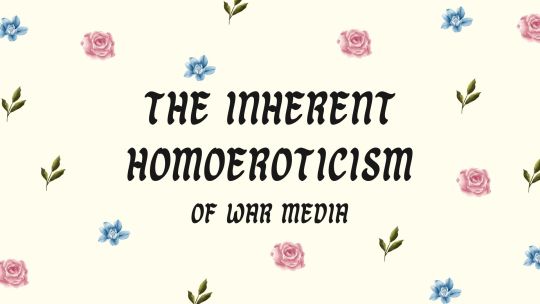

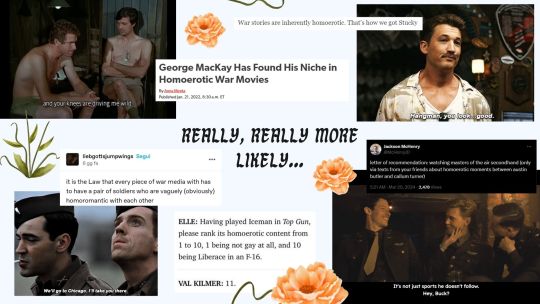
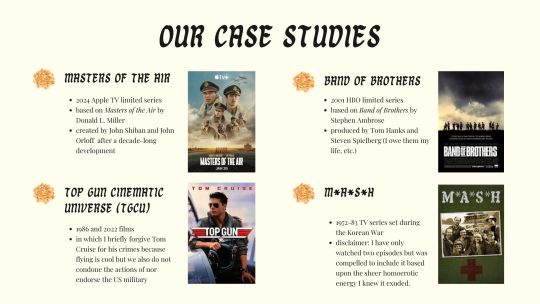


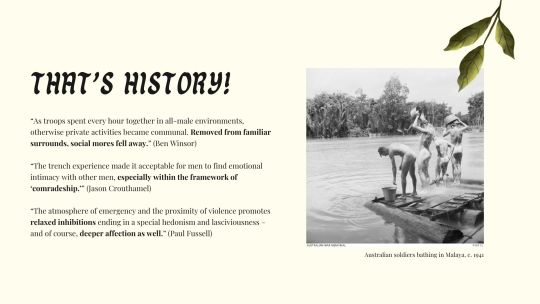
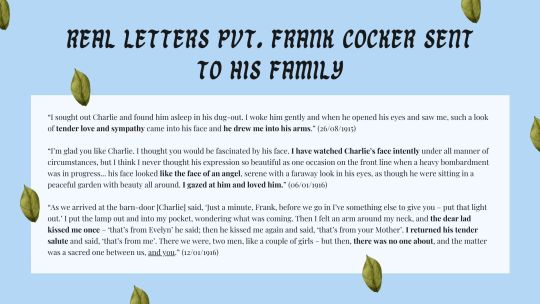


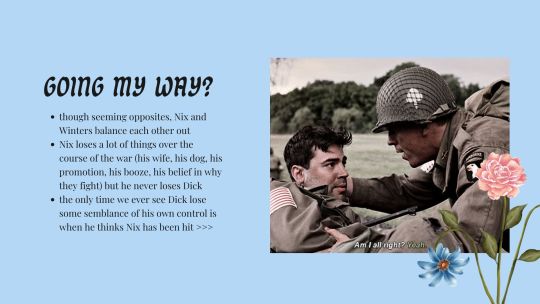
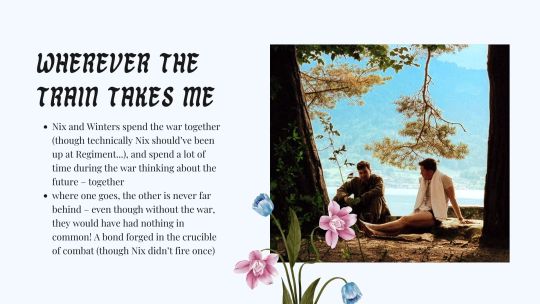

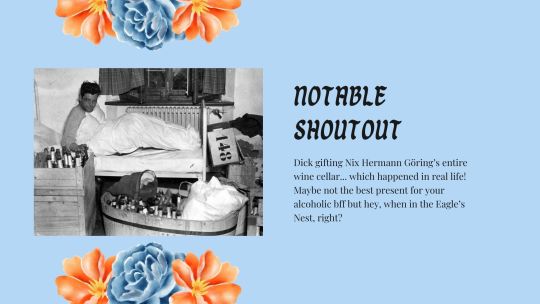
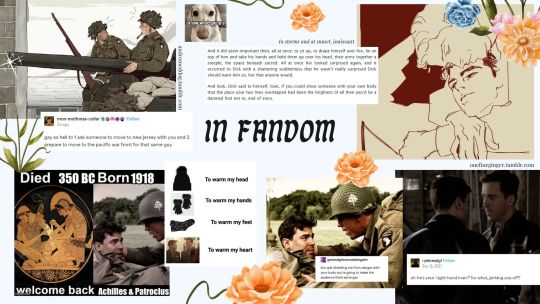





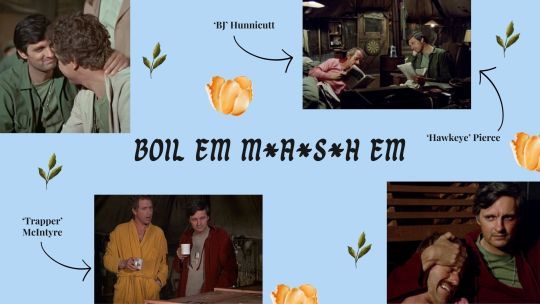
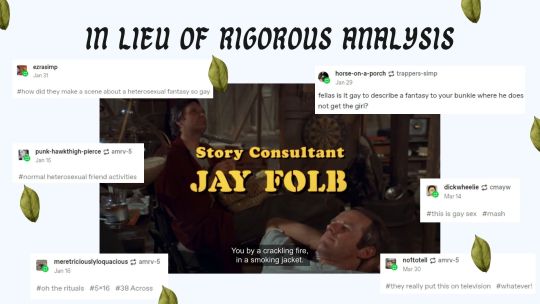

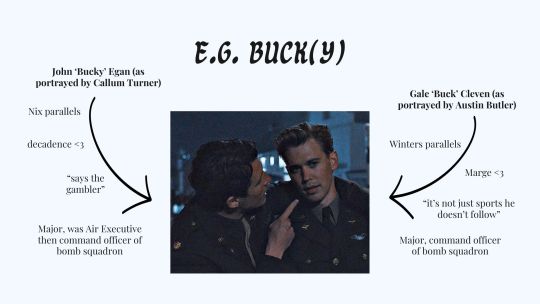




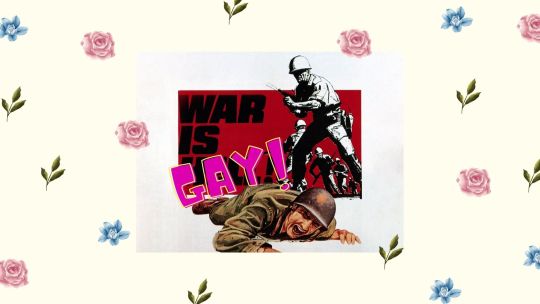
the inherent homoeroticism of war media: a completely unserious presentation by me
[note: some slides have been removed because they're literally just fancams and also i had more than 30 slides boo tumblr image limits]
BIBLIOGRAPHY (just going in order of slides)
and your knees are driving me wild - mash s02e08
george mackay has found his niche in homoerotic war movies
war stories are inherently homoerotic. that's how we got stucky
hangman you look good - top gun: maverick (gif by babyrooster)
letter of recommendation: watching masters of the air secondhand
it's not just sports - masters of the air e02
1 being not gay at all, 10 being liberace in an f-16
we'll go to chicago - band of brothers e01 (gif by @fkmylif3)
it is the law that every piece of war media
kim is a homoseggsual - kath & kim s01e02
Untitled (You Construct Intricate Rituals) - Barbara Kruger
The Secret History of Australia's Gay Diggers - Ben Winsor (+ Paul Fussell quoted within)
Sexuality, Sexual Relations and Homosexuality - Jason Crouthamel
Soldiers bathing in Malaya - AWM
Private Frank Crocker letters featured in Sebastian Faulks and Hope Wolf, A Broken World: Letters, Diaries and Memories of the Great War (2014), pp. 75-78.
mike's mic screencap my beloved <3
winnix gifs by @bandofbrothers2001 @preacherboyd @galebucky
winnix art by @andromeddog
winnix art by @onefineginger
In storms and at sunset by jouissant
winnix memes/text posts: 1 (@bleedingcoffee42) 2 (@krakerjaksstuff) 3 (@claudycod) 4 (@lewis-winters) 5 (@mon-mothmas-collar)
man is a hopeless creature i don't like much of anyone (@sluttyhenley)
You Create Intricate Rituals: The Homoerotic Action Movie - Rebecca Radillo (Lyvie Scott featured)
val kilmer icemav warrior compliation by @mavernick2
t as in top gun: maverick (@misaothewitch)
which is gayer (@holypowell)
we're fools to make war by whimsicule
all my roads lead back to you by liadan14
m*a*s*h video by @amrv-5 (+ reblog tags)
clegan/buck(y) gifs by @4o4notf0und @rcbertleckie
clegan fanart by @ifapromise <3
clegan memes: 1 (@rcbertleckie) 2 (@season-two) 3 (@ww2yaoi) 4 & 5
bomber's moon by moonrocks
**i tried to tag/link everything, if anything is broken or unsourced please let me know and i will endeavour to fix it! standard disclaimer that a) any discussion about war media based on real life people is based upon the fictional portrayals of those people and not the actual dudes. and b) this powerpoint was made for fun, it is not rigorous academic analysis. all opinions expressed are my own. please do not take it too seriously! that's all <3
#hbo war#hbowaredit#band of brothers#bobedit#masters of the air#mota#motaedit#top gun#top gun maverick#mash#m*a*s*h#clegan#winnix#hangster#icemav#liz makes things#web weaving#maybe?? idk!#GOD OK BE FREE GO INTO THE WORLD <3#edit i have since seen like 10 mash episodes but i'm not redoing this.#edit edit i just realised i have a citation for a mikes mic screencap that is not here bc its on a deleted slide oopsie
2K notes
·
View notes
Text
Okay, guys, I have to be so honest, the cyborg Jon stuff is not actually out of nowhere if you've been paying attention to the themes and ideas present in Jon's story. Actually, something to this affect has been hinted and foreshadowed all the way back in Supersons.
Jon's story, fundamentally, has always been about agency, and how being the son of a public figure like Superman hinders his ability to self-determinate. It is an idea that is present in every story, yes, every single one, starting from his debut as a character.
The cyborg stuff isn't meant to be a replacement of past traumas- it is an evolution, the thesis of what all the things he's been through have been leading up to. It is the ultimate culmination of everything Jon has been struggling with his whole life- being seen as nothing more but a tool that can be exploited.
Clark and Lois robbed Jon of knowledge about who he was for a large portion of his childhood (1). Manchester Black tried to use Jon as a weapon against his father, actively possessing him in order to do it, explicitly against Jon's wishes and opinions (2). Kid Amazo wanted to use Jon as a flesh puppet, a new healthy body that he could take over (3). Ultraman robbed years of his life and literally confined him in a place where he, literally and metaphorically, had no power. Jor El and Jon had a whole conversation about fate vs. free will in the age up arc (4). The entire central conflict of Son of Kal El was Jon fighting against a capitalist dictator who was trafficking marginalized people, altering and taking over their bodies for profit (5). Adventures of Superman Jon Kent has Jon going up against a version of his father thats a dictator, a man who has (in the words of the text) made the whole world a prison (6). In all of these situations, Jon's put in these positions specifically because he is the son of Superman, and he will forever be defined by it against his will. It is commentary on what it means to be the child of a hero, and it is an exploration of legacy that I think is very very interesting.
We've BEEN headed here! It was always going to come to some plotline of this nature. Sure, we couldn't know it'd be specifically this, him getting borged was specifically a surprise, but Mark Waid is an incredibly intelligent writer who knows what he is doing and does not just present events in a story, but ideas. The Speed Force is a love story. Absolute Power is about, well, power. And Jon Kent is fundamentally, at his core, about agency. The robot stuff isn't meant to be strictly literal!
Post Bibliography so you can check that I'm not bullshitting you. I didn't want to go look up panels because I'm laaazy, you can go see for yourself:
Superman: Lois & Clark by Dan Jurgens
Super-sons by Peter J Tomasi
Superman Rebirth by Peter J Tomasi
Superman 2018 by Brian Michael Bendis
Superman: Son of Kal El by Tom Taylor
Adventures of Superman: Jon Kent by Tom Taylor
#Guys please. Please consider the themes.#Comic books DO have them#Often its frustrating because frequently I see incredibly intelligent analysis followed by 'i wish it was intentional'#IT IS!!!! BELIEVE IN YOURSELF!!! BELIEVE IN YOUR ABILITY TO RECOGNIZE PATTERNS#you can recognize themes and patterns in a body of work dattebayo#jon kent#jonology#dc#dc comics#jonathan samuel kent
61 notes
·
View notes
Text
Palestinian History Between Great Powers - Part 1
From Bronze Age to Ottoman Palestine
I started writing this article months ago but as it deserves proper research, it took me a long while, and at one point I started questioning is this helpful anymore. I thought it's obvious at this point to anyone not willfully ignorant that what we are seeing in real time is a genocide, and I'm not going to convince those who are willfully ignorant. I decided to finish it anyway since I do feel obligation to do something and maybe providing some accessible historical context is what I'm capable of doing. Even if I probably won't change any hearts and minds, I think the least we can do is not forget Palestinians and fall into apathy. And at the very least more understanding of the situation is always better even when we already oppose this genocide.
This is quite out of my area of focus, so I will be doing more of a general overview of the history and link in depth sources by more knowledgeable people than try to become an expert on this. My purpose is to offer an accessible starting point for the history of Palestine to help people put historical and current events into their proper context. I don't think the occupation and genocide in Palestine pose complex moral questions - it's pretty simple in my opinion that genocide, apartheid and colonialism are wrong and need to stop for peace to be possible - but the history is complex and it's understanding needs quite a lot of background. I will do my best to represent the complexity accurately and fairly while keeping this concise. Since there is a lot of history, even if this is very general overview, it's still very long, so I did need to cut this in two parts. First part will be covering everything to the beginning of WW1, second part the British Mandate period and Israel period.
Bibliography
I'm linking my sources and further reading here so it's easy to check some specific resources even if you don't want to/have time to read 5 000 years of history right now. Because there's so much misinformation and propaganda, I read as much as I could from academic sources, linked at the top here. They are really interesting and delve deeply into specific subjects so I do recommend checking out anything that peaks your interest (Sci-Hub is your friend against paywalled papers and in JSTOR you can make a free account to access most papers). Some of them I didn't really end up using, but I still linked them here since they provide some additional context that wouldn't fit in this overview. At the end there's some accessible resources (youtube videos, podcasts etc.) which are relevant and I think good.
Pre-Ottoman Era
On The Problem of Reconstructing Pre-Hellenistic Israelite (Palestinian) History - Critique of Biblical historical narratives
Canaanites and Philistines
Archaeological Sources for the History of Palestine: Between Large Forces: Palestine in the Hellenistic Period - Everyday life in Hellenistic Palestine
Ottoman Era
Rediscovering Ottoman Palestine: Writing Palestinians into History - Critique of politics of Ottoman Palestine historiography
The Peasantry of Late Ottoman Palestine
Consequences of the Ottoman Land Law: Agrarian and Privatization Processes in Palestine, 1858–1918
The route from informal peasant landownership to formal tenancy and eviction in Palestine, 1800s–1947
The Ottoman Empire, Zionism, and the Question of Palestine (1880–1908)
Origins of Zionism
Christian Zionism and Victorian Culture
Zionism and Imperialism: The Historical Origins
The Non-Jewish Origin of Zionism
Zionism and Its Jewish "Assimilationist" Critics (1897-1948)
The Jewish-Ottoman Land Company: Herzl's Blueprint for the Colonization of Palestine
Books
Boundaries and Baraka - Chapter II of Muslims and Others in Sacred Space - Local syncretic religious beliefs of Muslim and Christian Arabs in Palestine
Further "reading"
Israelis Are Not 'Indigenous' (and other ridiculous pro-Israel arguments) - Properly cited youtube video on settler colonialism of Zionism (Indigenous is defined here in postcolonialist way, in contrast with the colonialist, the video doesn't argue that diaspora Jews didn't originate from the Palestine area)
Gaza: A Clear Case of Genocide - Detailed Legal Analysis - Youtube video detailing current evidence on the ongoing genocide and assessing them through international law
What the Netanyahu Family Did To Palestine: Part 1 , Part 2 - Two part podcast episode of Behind the Bastards about Israel's history and Netanyahu Family's involvement in it with an expert quest
History of Israeli/Palestinian conflict since 1799 - Timeline of Palestinian history by Al Jazeera with documentaries produced by Al Jazeera for most of the entries in the timeline
Ancient Era (33th-4th century BCE)
Palestine's location in the fertile crescent, the connecting land between Africa and Asia and the strip of land between Mediterranean and Red Sea means since the earliest emergence of civilizations it has been in the middle of great powers. Thorough it's history it has been conquered many, many times for it's strategic value. Despite the changing rulers and migrating groups there has been a continuous history history of a people, which has changed, split and evolved, but not fully disappeared or replaced at any point, which is quite rare of a history spanning thousands of years.
Speakers of Semitic languages are the first recorded inhabitants of Palestine. At least from Bronze Age (c. 3300-1200 BCE) onward they inhabited Levant, Arabian peninsula and Ethiopian highlands. Semitic languages belong in the Afroasiatic language group, which includes three other branches; ancient Egypt, Amazigh languages and Cushitic languages of African Horn. Most prominent theories of the origins of proto-Afroasiatic is in Levant, African side of Red Sea or Ethiopia. In the Bronze Age the Levant's Semitic speakers were called Canaanites and there was already urban settlements in Early Bronze Age. Egypt had been extending it's control over Canaan for a while and in Late Bronze Age, 1457 BCE, it took over Canaan. Gaza, which had had habitation for thousand years already, became the Egypt's administrative capital in Canaan. Canaan stayed as Egypt's province until the Late Bronze Age collapse c. 1200-1150 BCE, when Egypt started losing it's hold on Levant. Egypt eventually retreated from Canaan around 1100 BCE. The causes of Late Bronze Age collapse are unknown, but theories suggest some kind of environmental changes that caused destruction of cities and wide-spread mass migration all around the East Mediterranean Bronze Age civilizations.
Canaanites was not what most of the people called themselves, but rather what the surrounding empires, especially Egypt and Hittites in the north, called them. Philistines appear in Egyptian sources around the Late Bronze Age collapse as raiders against Egypt, who were likely populating southern parts of Canaan, the Palestine area. Several groups with mutually intelligble languages emerged after Egypt left the area: in Palestine area Philistines, Israelites, in Jordan are Ammonites, Moabites and Edomites, and in Lebanon area Canaanites, who were called by Phoenicians by Greeks. Israelites have been theorized to split from Philistines, possibly after Aegonean migrants during the Late Bronze Age collapse influenced the culture of the costal Philistine city states, and/or through Israelites development of monotheistic faith. During Iron Age these different groups descendant from Caananites had their own kingdoms. In the area of Palestine there was two Israelite kindgoms, Kingdom of Judah is the highlands of Judah, were Israelites likely originated, and Kindom of Israel or Samaria north to it, as well as Philistine city states in the coast around the area of current Gaza strip.
Earliest historical evidence of Israel is from mid 9th century BCE and of Judah from 7th century BCE, though Israelites as a group were mentioned earlier. It's entirely possible the kingdoms predate these mentions, but the archaeological evidence suggests likely not by much. Israel was conquered by the Neo-Assyrian empire in 722 BC, so it's entirely possible kingdom of Judah was created by retreating Israelites of the earlier kingdom. The remaining Israelites under Assyrian rule came to be known as Samaritans, marking also the split of Jewish faith into Judaism and Samaritanism. Neo-Assyrian lingua franca was Aramaic, a Semitic language from southwest Syria, which became the major spoken language in Samaria. Judah became a vassal state of Assyrians and later Babylonians. After a rebellion Babylonians fully conquered Judah in 586-587 BCE and exiled the rebels, though more recent historical study suggests it targeted the rebelling population and was not a mass exile. In 539 BCE Babylon and by extension Judah was conquered by Persian Achaemenid empire, which allowed the exiles to return and rule Judah as their vassals. Persia also conquered Samaria and Philistines. Aramaic was also the official language of the both Neo-Babylonian and Achaemenid empires and replaces Old Hebrew as spoken language in Judah too, though Old Hebrew continued to be written language of religious scripture and is known today as Biblical Hebrew. Otherwise in the Palestine area there were Edomites, who migrated to the southern parts of former Judah kingdom, and Qedarites, a nomadic Arabic tribal federation, in southern desert parts.
Biblical narratives tell this early history very differently, and for a long while, those were used as historical texts, but more recent historical study has cast a doubt on their usefulness in historical inquiry. Even more recent archaeological DNA studies (like this and this) have supported the historical narratives constructed from primary historical texts.
Antique Era (4th century BCE - 7th century CE)
Under Persian rule the people in the Palestine area had a relative amount of autonomy, which lasted about 200 years. In the 330s BCE Macedonians conquered Levant along with a lot of other places. The Macedonian empire broke down quickly after the death of Alexander the Great, and Levant was left under the control of the Seleucid empire, which included most of the Asian parts of the Macedonian empire. During this time the whole Palestine area was heavily Hellenized. In the 170s BCE the Seleucian emperor started a repression campaign against the Jewish religion, which led to a Maccabean Revolt in Judea, lasting from 167-160 BCE until the Seleucids were able to defeat the rebels. It started with guerilla violence in the countryside but evolved into a small civil war. Defeat of the rebelling Maccabees didn't curb the discontent and by 134 BCE Maccabees managed to take Judea and establish the Hasmonean dynasty. The dynasty ruled semi-autonomously under the Seleucian empire until it started disintegrating around 110 BCE, and Judea gained more independence and began to conquer the neighbouring areas. At most they controlled Samaria, Galilee, areas around Galilean Sea, Dead Sea and Jordan River between them, Idumea (formerly Kingdom of Edom) and Philistine city states. During the Hasmonean dynasty Judaism spread to some of the other Semitic peoples under their rule. It didn’t take long for the rising power of the Roman Republic to make Judea into their client state in 63 BCE. Next three decades the Roman Republic and Parthian Empire would fight over control of Judea, which ended by Rome gaining control and disposing of the Hasmonean dynasty from power. It was a client state until 6 CE Rome incorporated Judea proper, Samaria, Idumea and Philistine city states into the province of Judea.
The Jewish population was very much discontent under Roman rule and revolted frequently through the first century or so. It led to waves of Jewish migration around the Mediterranean area, which would eventually lead to the formation of European and North-African Jewish groups. The Roman emperor’s decision to build a Roman colony into Jerusalem, which they destroyed along with Second Temple while squashing the previous revolt, provoked a large-scale armed uprising from 132-136 among Judean Jews, which Rome suppressed brutally. Jerusalem was destroyed again, Jews and Christians were banned from there, and a lot of Judean Jews were killed, displaced and enslaved. Rome also suffered high losses. Jews and Christians hadn’t yet fully separated into different faiths yet, but this strained their relations as Christians hadn’t supported the uprising. Galilee and Judea was joined into one province, Syria Palaestina. Galilean Jews hadn’t participated in the revolt and had therefore survived it unscathed, so Galilee became the Jewish heartland. During the Constantine dynasty, in the first half of the 4th century, when Christianity was the Roman state religion, Jerusalem was rebuilt as very Christianized. After the Constantine dynasty the Jewish relations with Rome were briefly improved by a sympathetic emperor, until Justinian came into power in 527 and began authoritarian religious oppression of all non-Christians, casting the whole area into chaos. Samaritans rebelled repeatedly and were almost fully wiped out, while Jews joined forces with several foreign powers in an attempt to destabilize Byzantium rule. By 636 the first Muslim Caliphate emerged as victors over the control of Palestine.
Muslim Period and Crusades (636-1516)
For more than 300 years under the rule of Muslim Caliphate, Palestine saw a much more peaceful period, with relative freedom and economic prosperity. Christianity continued to be the majority religion and Christians, Jews and usually Samaritans were considered People of the Book, who were guaranteed religious freedom. Non-muslims though had to pay taxes and depending on the caliph had more or less restrictions posed upon them. The position of Samaritans as People of the Book was unstable and at points they were persecuted. For the position of Jews it was a marked improvement, and after the expulsion of Jews from Jerusalem by Rome in the 2nd century, they were finally allowed to return. Jerusalem became a religious center for the Muslims too, as it was considered the third most holy place of Islam. Cities, especially Jerusalem, saw Arab immigration. The rural agricultural population was mostly Aramaic speaking, though even while Palestinian Arabs had mostly been bedouins in the southern deserts, there were few Arabic villages from the Roman era. People of the Book were protected from forced conversions, but over time conversions among the Christian population slowly increased, until Islam became the majority religion. Cities became Arabicized and slowly Arabic (also Semitic language) replaced Aramaic as the majority language. Towards the end of the first millennium persecution of Christianity increased with the threat of Byzantium.
In 970 a competing dynasty, Fatimids, conquered Palestine beginning a new era of continuous warfare and conquest by foreign powers. In the beginning of the new millennium Palestine was conquered by the Turco-Persian Seljuk empire for a couple of decades, recaptured by Fatimids for only a year, until the Crusaders took Palestine in 1099. During the next two centuries Palestine exchanged hands several times between the Crusaders and the Egyptian Ayyubid Sultanate. After internal struggle the Ayyubid dynasty was overthrown by the mamluk military caste and them in lead, the Sultanate secured Palestine. First they repelled the invading Mongol empire in 1260 and by 1291 they had defeated the remnants of the Cusaders and their Kingdom of Jerusalem. The period was devastating to the Palestinian populations, cities and economic life. The Crusaders especially committed numerous massacres against non-Christians and under Muslim rule Christians were persecuted and forcibly converted. The next two centuries under the Mamluk Sultanate were peaceful and Christian and Jewish communities were afforded some self-governance and relatively high religious freedom for being recognised as People of the Book again. The state had a more contentious relationship with Christians as the wars with the Crusaders were still looming between Christians and Muslims, and at some points Christians faced persecution and forced conversions.
Ottoman Period (1516-1917)
The Ottoman Empire gained dominance in western Asia over the Mamluk Sultanate during the late 15th century and conquered Palestine in 1516. It became a great imperial power in Asia and Europe for two centuries and in the 18th century started a slow decline, eventually becoming the "Sick man of Europe". The Ottoman Empire was very decentralized and under it Palestine was at first ruled by three Palestinian families semi-autonomously. The Ottoman state didn’t pay much attention to economic development, as they considered it contrary to their chivalric culture, so they instead attracted foreign businesses with the capitulation system. Capitulations were treaties between Ottomans and a foreign power by which the citizens of that foreign power were under their jurisdiction inside Ottoman borders. This guaranteed safety and religious freedom for non-Muslim merchants and exempted them from any additional taxes applying to foreigners and non-Muslims, which encouraged them to build businesses in the Ottoman Empire. Ottomans also intentionally attracted European Jews, who faced persecution and pogroms, and had built effective international trade networks through the tight knit diaspora communities. Jews and Christians had quite well secured position in the empire as People of the Book, but Samaritans were persecuted after they had sided with the Mamluk Sultanate against Ottomans and later for being considered "pagans". City elites adopted Turkish culture, while in rural areas peasant villages and Bedouin clans remained Arabic. The rural areas were very much self-governing as both villages and Bedouin clans were fairly self-reliant with their own political structures. Villages consisted of clan-like family groups, hamulas, and the village lands were distributed between their collective ownership.
In the 19th century the Ottoman Empire was leaving behind European imperial powers in economic and military development. With the rise of the international capitalist markets, capitulation approach, which had worked well for the empire in previous centuries, was extended to markets as a very laissez faire economic policy. This did not lead to hoped economic growth however, but rather deindustrialization. The Ottoman Empire opened itself to markets it couldn’t compete in and its resources were then easy to exploit by stronger economies. The other powers, such as the European powers, avoided this by first cultivating strong national industries with protectionist policies, and then opened to international markets. The capitulation system also became a political liability the way it interacted with the protégé system. The Ottoman Empire had agreed to allow some European powers to give their protection over certain minority religious groups (mostly Christian groups) in the Empire, allowing members of those groups to claim citizenship of their protectorate nation. This had allowed those Ottoman citizens to claim the benefits of the capitulation system and cultivated trade and business for the Empire. In the 19th century the European powers, notably France, British Empire, Germany and Russia, turned their interests towards Levant which was important for their access to their colonial interests in Asia and Africa. They had a vested interest in the continuing power of the weakening Ottoman Empire, which they believed they could control through economic dominance and the protégé system. It became a competition on who could gain the most influence in the Ottoman Empire. In Palestine this led to a change in class dynamics. Christian protégés of European imperial powers were given tax exemptions from the increasing taxes, which were implemented to balance the national deposit, and better opportunities to gain wealth from international trade, turning the urban Christian Arabs into elite.
In 1832 Egypt invaded Palestine, marking a point of more rapid decline of Ottoman rule. Egypt attempted to “modernize” Palestine, which was considered backward, but Egypt's policies, especially conscription, were considered intrusive. The local self-ruling clans and families were resistant to outside powers and with their sway over the population, they rose to a popular uprising after two years of Egyptian rule. The suppression of the uprising devastated many villages and Egypt still failed to enforce order and halt violence. In 1840 Britain intervened, returning its control back to the Ottomans. They didn’t yet have capitulations with the Ottomans and were concerned over the other European powers gaining influence over the aging empire, so in return for their military assistance, they gained capitulations and named Jews and Protestants as their protégés in Levant. Palestine rapidly opened to the international markets with the increase in capitulations combined with the laissez faire fiscal policies of the empire, allowing European powers to turn Palestinian cities, especially in the coast, to centers of trade. In 1858 the Ottoman Empire also attempted to privatize land ownership to increase agricultural production and profitability in order to help with their financial troubles. Most Palestinian land was public land, but in practice owned informally by the villagers cultivating it. As long as they paid taxes, they couldn’t be evicted, which rarely happened in those cases either, and their rights to the land were hereditary. The land reform codified and formalized land ownership and removed barriers to non-villagers gaining ownership of peasant land, laying groundwork for commodifying land. The Ottoman Empire also allowed foreigners to purchase private land. This didn’t immediately lead to large-scale transfer of land ownership, but increasing taxes impoverishing the peasantry and indebting them transferred land from its cultivators to urban absentee landlords. Peasants started to turn into landless tenants and a new type of large estates were established.
Birth of Zionism
The British pushed for more control over Levant, since they wanted to secure their access to India and their colonial ventures in Africa. They didn’t have much interest in colonizing Levant themselves, which is why they were interested in backing the Ottoman Empire and gaining stronger control over it via European Jewish immigrants. European Jews had been immigrating to Palestine in small numbers for a while for religious reasons, to escape persecution and to take advantage of the economic opportunities offered by the Ottoman Empire. The British though also had religious interests in supporting Jewish migration to Palestine. Since the early 19th century, there had been a growing religious movement of Christian Zionism, who sought to restore Jews into Palestine and then convert them to Christianity to cause the second coming of Jesus and the end times. As you do. They were considered fanatics, even lunatics, for their literal interpretations of prophecy, but they were enthusiastic imperialists and when they expressed the idea of restoration of Jewish Palestine in imperial terms, it gained popular acceptance in Britain. Some of the common talking points originating from Christian Zionism were Jews had the right to Palestinian land for Biblical reasons, the only way to not let the “underdeveloped” agrarian land go to waste was colonialism, and Jews would be a civilizing force in Palestine. While the end goal of Christian Zionists was conversion of Jews, they had Orientalist reverence for Jews, but among the wider imperialist support for these ideas there was in addition an explicitly antisemitic aspect. The imperialists' idea was that Britain, and Europe more broadly, could this way also get rid of the Jews.
The trouble was that at the time there was no wide interest at all among Jews to colonize Palestine. The Jews who were migrating there during the first half of the 19th century did so with all intentions of integrating to the Palestinian society. European Jews had since Enlightenment and the French Revolution gained unprecedented levels of social acceptance and equality (which still wasn’t very much), and liberal assimilationism had become the dominant ideology especially among Jewish elites. Assimilationist Jews considered Judaism a religious identity, not an ethnic one, and they rather identified with their nationality. In the latter half of 19th century Jewish socialism was contesting the liberal Jewish idea that antisemitism could be overcome with individualist approach and instead demanded structural change. During the century it became increasingly clear that the assimilationist approach couldn’t fix antisemitism as racial ideology and exclusionist ethnonationalism were gaining traction and fueling antisemitism, which culminated in the 1880s pogroms in Russia and 1894 Dreyfus Affair in France. These events certainly promoted socialist approach among many Jews, but the Jewish elite were certainly not interested in socialist solutions, where they would lose their elite status, even if for white Christians they were all second class citizens. So instead, like many elites facing the threat of socialism, they turned to nationalism. To the question of how to build a nation from a diverse diaspora, they found the answer from Christian Zionism. Jewish Zionism was distinctly secular, so while they did adopt many religious and biblical narratives and goals of Christian Zionism, they put them in nationalist terms. Their end goal was of course different from that of the millennialist Christians so Jewish Zionism was presented as a practical and rational alternative to utopian fanaticism, but they were still natural allies. Zionism was opposed in the European Jewish communities by both assimilationists and socialists, who both viewed it as countering the efforts of opposing antisemitism, which Zionists saw as an inherently impossible endeavor, and also by Orthodox Jews from a religious standpoint. Orthodox Jews denounced the secularization of the Promised Land, which according to them could only be bestowed by God and couldn’t be a state with secular power.
Before Zionism was fully formalized as a movement, there were proto-Zionist movements in Eastern-Europe as a direct response to the pogroms, with the goal of settling Eastern Jewish refugees to Palestine from 1881 forward. This is considered to be the start of the First Aliyah, the explicitly Zionist mass migrations to Palestine. The funding was secured from the European Jews, and with it the Zionists bought land from the absentee urban landlords with large estates and evicted the tenants in order to form Zionist colonies. This raised concern among Ottoman officials, who had become vary of the European exploitation of their capitulation system, which increased European influence with the immigration of European Jews. They were also concerned about the rising Arab nationalism in Palestine provoked by the European economic exploitation and even more pressingly the peasant displacement. The Ottoman Empire was already facing massive difficulties with nationalist movements in different parts of the empire, like in Armenia. They attempted to restrict Zionist land purchases with legal restrictions and failed.
The 1880s settling to Palestine was still unorganized and leaderless until Theodor Herzl, who is considered to be the founder of Zionism, joined Zionist ranks in mid-1890s and began formulating a colonialist venture in earnest. The British were supportive of the Zionist project, but as long as the Ottoman Empire was in charge of Palestine and the British could extend control over it, they weren’t interested in establishing such a state themselves. So the Zionist movement with Herzl in the lead turned to the Ottoman Empire in 1901. He envisioned the Zionist colonial project as a land company, modeled after the British and Dutch East Indian Companies, which would under imperial blessing operate fairly independently and govern over colonized land. The end goal was to build an ethnonationalist Jewish state and expel the native population. There were even dreams of Jewish empire that would colonize neighbouring countries, “civilize” them and bring them “prosperity”. To persuade the Sultan, Herz proposed to pay for the Ottoman Empire’s depts with European Jewish investments in exchange for allowing the Zionists to settle and govern Palestine. The Ottoman government was well aware of Zionist movement’s end goals and their alliances with European Imperialism, rejecting their proposals.
The Zionists evaded Ottoman restrictions anyway and continued to settle Palestine with British backing. European powers then pressured Ottomans to abolish those restrictions allowing a new wave of Zionist colonialism. The violence and pogroms in Russia had convinced some of the Eastern European Jewish socialists that fighting antisemitism was impossible, so they created Labor Zionism and used the “untouched land” to experiment with utopian socialist communes. In the process they displaced indigenous peasant hamulas, which had often for centuries farmed the land in communal ownership. Mass migration and eviction quickly provoked a predictable opposition in the Palestinian population and spread of Arab nationalist thought. This second wave of Aliyah ended at the First World War, which was also the end of the Ottoman Empire.
#history#palestine#palestinian genocide#palestinian history#colonization#colonial history#zionism#islamophobia#ottoman empire
164 notes
·
View notes
Text
Pro-endos: Name a single doctor that has said you need a disorder or trauma to be plural. Anti-endos: *Lists off some random names* Pro-endos: Cool. Can you cite where they actually said that? Anti-endos: Now you want PROOF instead of just taking our word for it? How dare you move the goalposts by asking us to prove our claims? We gave you random names and now it's your responsibility to educate yourself by combing through literally everything these doctors have said through their whole lives until you either find something that proves us right or your mortal coil expires and rots away.
I get being annoyed by legitimate moving of goalposts. I often am myself because sysmeds love this as their go-to tactic. I'd be able to buy Twitter if I had a penny for every time a sysmed asked for evidence of a doctor being pro-endo, and then when given proof, makes up some stupid reason it doesn't count.
I've seen "Dr. Eric Yabrough doesn't count because he's an LGBT psychiatrist and doesn't specialize in dissociative disorders," "Dr. Colin Ross doesn't count because he's studied some weird things in addition to having 40 years of experience studying dissociative disorders," "these psychologists who conducted an fMRI study on tulpamancy don't count because the psychologists were talking about it on Reddit," "research on tulpamancy is irrelevant because people on the internet told me tulpamancy is an offensive word," "only .edu/.gov are valid sources," "sources older than ten/five/two/whatever-number-I-make-up years are expired and no longer count," and so many other ridiculous excuses to dismiss professional opinions on endogenic systems. Sysmeds love moving goalposts.
But... I feel that, when asked to name anti-endo doctors... being able to cite the specific quote should be the bare minimum. Providing evidence should be inherently implied as part of the assignment.
And if you're unable to do that and resort to an ad hominem, accusing the person asking of being ableist in order to shut them up, I'm going to assume that it's because you're lying.
Because in theory, if you knew where these doctors had said the things you're claiming they said, you would be able to cite it.
In the end, moving goalposts is typically about demanding new evidence when the initial standards of evidence set by the discussion are met. If an anti-endo asks for a doctor that has said you can be plural without trauma, and you provide one with a citation, you've satisfied those goalposts with evidence.
If a pro-endo asks for you to name a doctor who has said you can't be plural without trauma, and you drop names with no citations, you still have no evidence. You're making an Argument By Assertion. Commonly known on the internet as a "trust me bro."
And expecting the person asking the questions to comb through the massive bibliographies of the doctors you named just to find where they said what you claim they said is shifting the burden of proof.
I can't see these sorts of tactics by anti-endos as anything more than bad faith attempts at shutting down discussions.
#syscourse#pro endogenic#pro endo#systempunk#syspunk#system punk#sys punk#psychology#psychiatry#sysblr#arguments#debate#burden of proof#logical fallacies#multiplicity#endogenic#systems#system#actually plural#actually a system
69 notes
·
View notes
Text
According to EN World (I mean I wouldn't know and couldn't possibly be bothered) the author of this tweet is "former gaming executive turned culture warrior Mark Hern".



The Making of Original Dungeons & Dragons is a WotC book that just came out for the game's 50th anniversary, and the passages are from "the foreword written by Jon Peterson, one of the foremost historians about Dungeons & Dragons and who also collaborated with Wizards of the Coast on the book".


Elon Musk, famous idiot, immediately piped in supporting the tweet

and obviously fuck Musk and fuck the "culture warriors", here's how I see it (without having read the book, but I'm confident my guesses are educated enough).
This book is promotional material. The good part is that it brings to light primary documents, which are invaluable for research. The bad part is that it's promotional material, like everything that comes out of WotC. No one should trust a fucking brand (silence, brand) to tell its own story. I've read some of Jon Peterson's previous work, and I thought he's an excellent researcher but only moderately able to pick up the prejudices baked in the hobby. Gets some of it, misses a lot. I'm guessing his criticism came about by WotC's own request, and would not be printed if their PR team (and legal team, probably) didn't approve it. And I'm gonna note that said criticism, while in the right direction (to be clear, the basic stance of "this was shitty, but erasing it from history and pretending it didn't exist doesn't help; what helps is acknowledging the shittiness" is absolutely correct), is very light and very careful. The history of D&D needs STRONGER criticism, which will never happen in a WotC publication.
And what I'd like to see is a comprehensive critical history of D&D, which I don't think exists yet. We have EITHER involved and well-researched but largely uncritical histories, even when they delve deep into the cultural environment that made D&D's birth possible, OR works that explore a single topic or focus on a handful of problematic™ elements. AFAIK. If I'm missing something, by all means, let me know! Here's my bibliography so far (not including papers, which can be VERY critical):
David M. Ewalt, Of Dice and Men: The Story of Dungeons & Dragons and the People Who Play It (Scribner, 2013)
Jon Peterson, Playing at the World: A history of simulating wars, people and fantastic adventures, from chess to role-playing games (Unreason Press, 2012)
Michael J. Tresca, The Evolution of Fantasy Role-Playing Games (McFarland, 2011)
Jennifer Grouling Cover, The Creation of Narrative in Tabletop Role-playing Games (McFarland, 2010)
Sarah Lynne Bowman, The Functions of Role-Playing Games: How Participants Create Community, Solve Problems and Explore Identity (McFarland, 2010)
Joseph P. Laycock, Dangerous Games: What the Moral Panic over Role-Playing Games Says about Play, Religion, and Imagined Worlds (University of California Press, 2015)
Ashley ML Brown, Sexuality in Role-Playing Games (Routledge, 2015)
and the promos
30 Years of Adventure: A Celebration of Dungeons & Dragons (WotC, 2006)
Michael Witwer et al, Art & Arcana: A Visual History (Ten Speed Press, 2018)
Michael Witwer, Empire of Imagination: Gary Gygax and the Birth of Dungeons & Dragons (Bloomsbury, 2015) [not a promo per se, but fully a eulogy]
31 notes
·
View notes
Text
PROMPTS FROM RED, WHITE & ROYAL BLUE * assorted (and slightly adapted to suit this meme format) dialogue from the book by casey mcquiston, adjust as necessary
on purpose. i love him on purpose.
i've always thought of myself as a problem that deserved to stay hidden.
i'm going to have you offed. you'll never see it coming.
take anything you want and know you deserve to have it.
get in there.
you're literally putting your dick in the leader of a foreign state.
before you, i was all right letting everything happen to me.
i can't believe even mortal peril will not prevent you from being the way you are.
sorry, are we not? did i skip ahead again?
you've been warned.
he died as he lived: avoiding plans and sucking cock.
my life is a cosmic joke and you're not a real person.
hey, have i told you lately that you're brave?
i honestly have never thought i deserved to choose.
we're gonna make it work. you and me and history, remember?
if you finish that sentence, i'm gonna spend tonight in jail.
but the truth is, also, simply this: love is indomitable.
i actively wish for the sweet release of death.
yes, good, carry on.
i won't hear a word against it.
we're gonna do it together.
i said you look great, baby!
i meet you in every dream, and when i wake i cannot close my eyes again for ruminating on your sweetness.
i'm so in love i could die.
you can take your legacy and your decorum and you can shove it up your fucking arse.
i wonder if it's too late to swan dive off the roof.
i'm learning all your hidden depths today, sweetheart.
you must invent an entirely new system.
a curious thing about grief is the way it takes your entire life, all those foundational years that made you who you are, and makes them so painful to look back on.
he's proof that it doesn't matter where you come from or who your family is.
i've bloody well had it!
we can unpack the ironic symbolism later.
that's beyond our sense of decorum!
i'm not afraid of anything i feel. i'm afraid of saying it. i'm only afraid of what happens when i do.
aw, you do care.
if there's any legacy for me on this earth, i want it to be true.
straight people probably don't spend this much time convincing themselves that they're straight.
the moment you first called me a prick, my fate was sealed.
you are the absolute worst idea i've ever had.
should i tell you that when we're apart, your body comes back to me in dreams?
can you perhaps stop putting your sodding life in danger now?
what are we even defending here?
history will remember us.
when i sleep, i see you.
i hate this so much.
every person who bears a legacy makes the choice of a partner with whom they will share it with.
we're just gonna fucking fight.
he is my choice.
i can appreciate that maybe this isn't your fault.
i've been gay as a maypole since the day i came out of mom.
when i wake up in the morning, it feels like i've just been with you.
i can feel your skin against mine, and it makes every bone in my body ache.
your spine's a ridge i'd die climbing.
for a few moments, i can hold my breath and be back there with you, in a dream, in a thousand rooms, nowhere at all.
the phrase 'see attached bibliography' is the single sexiest thing you have ever written me.
i promise you, one day we'll be able to just be, and fuck everyone else.
give yourself away sometimes, sweetheart. there's so much of you.
i want to set myself on fire, but i can't afford for anyone to see me burn.
you see, for me, memories are difficult.
never tell me the odds.
i wish there weren't a wall.
jesus christ, it's like they can see into your soul.
you're it, okay? i'm never gonna love anybody in the world like i love you.
i'm finished. i don't care.
god, i want to fight everyone who's ever hurt you.
the whole world watched, and history remembered.
are you quite finished?
just so we're clear. i'm about to have sex with you in this storage closet to spite your family.
you insane, hopeless romantic little shit.
#rp meme#rp memes#rp prompt#rp starters#roleplay memes#roleplay prompt#ask meme#ask memes#roleplay meme#roleplay inbox prompts#writing prompt#askbox meme#rp asks#inbox prompts#inbox prompt#rp inbox meme#inbox meme#sentence starter#sentence starters#sentence starter prompt#mcflymemes#red white and royal blue#rwarb#book prompts
278 notes
·
View notes
Text
Germanic Paganism Resource Masterlist
Notes: - Updates will be beyond infrequent. - Feel free to pop into my ask box requesting resource recommendations at any moment. - Resources do not reflect my personal beliefs or practice. I may include otherwise great resources that include theories and ideologies I do not support (such as the 'sign of the Hammer'), because I make extensive use of cross-referencing, reflection, etc to determine everything I incorporate into my craft. - I will never consciously add resources written by (Neo-)Nazis and the like. If you spot them, feel free to let me know. - You may notice there is a seemingly disproportionate amount of sources also or primarily talking about Scandinavia and Iceland, and even some primarily covering England. This is because continental Germanic paganism has only barely survived the ravages of time, and one can only learn about it if they supplement their knowledge with the more complete pictures of Anglo-Saxon paganism and Norse paganism.
Legend: [No language identifier means the source is English.] [D] - The resource is written (primarily) in Dutch. [G] - The resource is written (primarily) in German. [ON] - The resource is written (primarily) in Old Norse. [OD] - The resource is written (primarily) in Old Dutch. [OG] - The resource is written (primarily) in Old High German. [L] - The resource is written (primarily) in Latin. [F] - The resource is written (primarily) in French. * - I have not read the resource in its entirety. ** - Read with caution. !! - There is more of the resource available/this is one part of multiple.
Historic Texts and References
Tacitus' Agricola and Germania
Tacitus' Annals
The Prose Edda
The Poetic Edda
The First Nine Books of the Danish History of Saxo Grammaticus
Contemporary Books, Essays, Other Media
Myths and symbols in pagan Europe : early Scandinavian and Celtic religions - H.R. Ellis Davidson
Kleinere Altniederdeutsche Denkmälen - Heyne [G]*
Religion and Philosophy in Germany : a Fragment - Heine *
Deutsche Volkskunde - Adolf Bach [G]*
Teutonic Mythology - Grimm
Swedish Legends and Folk Tales - John Lindow
Scandinavian Mythology : an Annotated Bibliography - John Lindow *
Trolls : an Unnatural History - John Lindow
Myths of the Norsemen from the Eddas and Sagas - H.A. Guerber
Northern mythology : comprising the principal popular traditions and superstitions of Scandinavia, North Germany, and The Netherlands - Benjamin Thorpe | VOL 1, VOL 2, VOL 3
From Myth to Fiction : the Saga of Hadingus - Georges Dumézil *
The Stakes of the Warrior - Georges Dumézil **
Gods of the Ancient Norsemen - Georges Dumézil **
Zum Tamfana-Rätsel - Edmund Weber [G]*
De Tijdstippen van de Cultische Jaarfeesten - Boppo Grimmsma [D]**
Nederlansche Volksoverleveringen en Godenleer - Van den Bergh [D, OD]*
Tales and Legends of Tyrol *
Germanic Spirituality - Bil Linzie
Handwörterbuch des Deutschen Auberglaubens - Baechtold-Staubl, Hoffman-Krayer
Goden van de Lage Landen - Gunivortus Goos [D]**
Runic and Heroic Poems of the Old Teutonic Peoples - Dickins *
Gods and Myths of Northern Europe - H.R. Ellis Davidson
Old Norse - Icelandic Literature : a Critical Guide - John Lindow
Vikings : a Very Short Introduction - Richards *
Norse Mythology : a Guide to the Gods, Heroes, Rituals and Beliefs - John Lindow
Antwoord op de Vraag, door het Zeeuwse Genootschap de Wetenschappen - te Water [D]*
Verhandelingen over het Westland, ter opheldering der Loo-en, Woerden en Hoven, benevens de natuurdienst der Batavieren en Friezen - Buddingh [D]*
De Goden der Germanen - de Vries [D]*
Norse Revival: Transformations of Germanic Neopaganism - Stefanie von Schnurbein (in the series Studies in Critical Research on Religion which I highly recommend)
Digital Libraries, Dictionaries and the Like
Digitale Bibliotheek voor Nederlandse Letteren [D]*
Digitised Collection of Historic Sources of the WWU in Münster [G, D, OD, OG]*
Oudnederlands Woordenboek [D, OD]*
Ons volksleven : tijdschrift voor taal-, volks- en oudheidkunde. Jaargang 2-12 [D]*
Het Rad - Digitale Bibliotheek voor Germaans Heidendom, Runen, Seidr [D]*
Volkskunde (search results on Delpher) [D]*
Goden van Eigen Bodem - Digitale bibliotheek voor heidens erfgoed van de lage landen [D]*
Godinnen van Nederland en België [D]**!!
Forgotten Gods - Reginheim **
The Rune Poems *
Kronieken van de Westhoek (Flemish Folk History) [D]*
Brabantse Folklore, bulletin van de provinciale dienst voor geschiedkundige en folkloristische opzoekingen [D]*
Project Gutenberg has a wealth of resources about pre-christian Germanic religion*
Mimisbrunnr.info has a wealth of information including starter guides.
Author Recommendations
J.R.W. Sinninghe [D]
John Lindow
Benjamin Thorpe
H.R. Ellis Davidson
The Grimm Brothers
J. Haver [D]
To be continued.
56 notes
·
View notes
Text
So I just got sent that pretty iconic "anti-tulpa" document and I think it's pretty damn funny that a lot of those sources, if you actually READ them, are neutral or even supportive lmfao.
Like for this one? This is straight up pro-, and is just explaining that "tulpamancy" isn't the original concept and that it's based on other practices. Congrats, you're making our fucking point for us!
This next one is pretty interesting also. I wanna highlight some stuff from it, from both the op and comments.
Let's talk about my existence in contrast to some of these statements. The first one is "The biggest, most dangerous form of evil in Buddhist thought is "ego" or self-grasping. If ANY mental phenomena increases your self-cherishing attitudes (self importance, grandiosity, jealousness, craving, hatred, self-loathing, self-absorption etc) it's evil. IF a mental phenomena causes greater flexibility, less attachment, more tranquil emotions, less mental chatter/discursive thinking, increased generosity and compassion toward others, higher mental clarity etc.--that's good." And the second one is "If it increases negative emotions, it's not Dharma. If it decreases negative emotions, it's Dharma." So these are great for some people, but that mentality of not allowing "self-cherishing attitudes" can be EXTREMELY HARMFUL FOR SYSTEMS and ANYONE with self worth issues. A lot of this is contradictory for a lot of people. Something can both decrease negative emotions and make you feel connected to yourself. Nobody has the right to make us feel any less like ourselves - normally you can believe whatever you want for yourself, obviously, but pushing it onto other ppls' lives aint cool. The implication that we're straight up DANGEROUS just for existing is insulting to created systems regardless of whether you're using the word tulpa or not.
The reply to that by @/eeveecraft is great, and this part describes how weird that is in the context of headmates' identities here. "Furthermore, really don't like how you downplayed tulpas as property there, buddy. Tulpas are not property, they are people in every sense of the word, and I don't [give a] flying fuck about whatever complications that for your beliefs. My systemmates are people, full stop. I was already able to tell since you refer to your own systemmates as "imaginary friends," which a lot of tulpas aren't okay with being called that because that implies that they're fake. They are NOT lesser because they're not created by ancient monks or whatever.
"Like, seriously: "They would be considered "as real as you and me," with their own likes and dislikes etc," because apparently, modern tulpas don't have likes and dislikes and their hosts just see them as delusions? Say that to my tulpa, Arcanus who adores coffee while the smell makes me nauseous, say that to my systemmates who switch with me and have their own hobbies. Also, tulpas are more than just personalities. They have their own experiences, skills, preferences, dreams, memories, thoughts, a person is more than just their personality, and I thought a "licensed psychotherapist" would know that, especially if they have systemmates of their own." Make sure to read the full comment tho cuz it's a good takedown, it's not just about that it goes thru the entire thing.
SO! If anybody actually wants a well-studied paper outlining everything, check out Tracking the Tulpa: Exploring the "Tibetan" Origins of a Contemporary Paranormal Idea by Natasha L. Mikles and Joseph P. Laycock. It goes into a lot more of an accurate and in-depth history on the subject, and the bibliography ACTUALLY shows where things come from.
All that document showed us was that Buddhists are a wide community with a variety of different people with different skill levels, understandings, and opinions. And that we need to ditch the fantastical, impossible representation of the tulpa in supernatural media because that's ACTIVELY harming people. Which is what we want to show people! So congrats!
#im not linking it cuz its cherry picked as hell#but if youve been here a while you know what it is#if you want the document shoot me a message#that shit needs to stop circulating#syscourse#tulpacourse
59 notes
·
View notes
Note
Having read some of your older posts on Mercedes Lackey (and thus going in with mostly-full knowledge of Everything), I want to give her books a try…but there are so many of them. Any you recommend as a starting point?
Hmmm. I've probably only read one-fifth of her bibliography, so other people might have different suggestions. Speaking personally, the series of hers I think holds up best is the Tarma&Kethry&Kerowyn arc - Oathbound, Oathbreakers, Oathblood, and By the Sword. The last one technically stands alone, but it's fun to know the backstory.
I think they're some of Lackey at her best - a blend of worldly cynicism and deep moral ideals, willing to let her characters be a bit messy and interesting.
If you want to get into the Heralds of Valdemar... God knows. There was originally a trilogy of trilogies that had the big plot (OG Heralds of Valdemar/Arrows of the Queen, Mage Winds, Mage Wars) but now there are so many prequels and sequels and tie-ins, I think you could potentially pick a series that sounds interesting and dive in there. I personally don't like anything she's written in the last 20 years, but her new books still have an audience.
Other series I know people still love after all this time are Elemental Masters and Bedlam's Bard, though I haven't read them myself.
Other people will, of course, have their own opinions to contribute. That's what we do on Tumblr. Do hot takes and piss on the poor.
41 notes
·
View notes
Text
A (Negative) Review of Tom Taylor's Nightwing Run - What Went Wrong? Bludhaven (PART 1)
Introduction Who is Dick Grayson? What Went Wrong? Dick's Characterization What Went Wrong? Barbara Gordon What Went Wrong? Bludhaven (Part 1, Part 2) What Went Wrong? Melinda Lin Grayson What Went Wrong? Bea Bennett What Went Wrong? Villains Conclusion Bibliography
Dick and Babs’ relationship also comes at the cost of something crucial: the citizens of Bludhaven.
Because Dick is often either with Babs or interacting with his other superhero connections, he does not engage with the people he is meant to protect. As a result, we as readers do not get to know the people of Bludhaven, much less grow to care for them. Bludhaven is barren. The only ones Dick interacts with are Babs, Titans, and occasionally Melinda. He is Bludhaven's protector but he has built no relationships with the people in his city.
When Dick’s apartment building blew up, Wally quite removed Dick from Bludhaven, robbing him of the opportunity to interact with his neighbors, with Clancy, or even his enemies. Having the Titans in Bludhaven further exacerbates this problem by creating a distance between Dick and the others in the city. Dick may be in Bludhaven, but he is not interacting with the people of Bludhaven. He literally lives in a tower removed from the rest of the population. Dick does not have a job of his own, we do not get to see him working for the Alfred Pennyworth Foundation, and because now he gets to be Nightwing more often, he is robbed of even more opportunities to experience a normal daily life in Bludhaven. By having Dick move into the Titan's tower, interact primarily with Babs and the Titans, and work solely as Nightwing, Taylor created a rift between Dick, his city, and its people.
As another Dick Grayson Fan put it in a discussion (From here on referred to as Dick Grayson Fan C):
“The problem [with the current iteration of Dick and Barbara’s relationship] has been there for years but what really brings it out in Taylor’s run - apart from DickBabs being attached at the hip - is that his Bludhaven is just very gentrified. It’s a reflection of the DickBabs relationship. And because Taylor can’t write more than one shallow plot, it’s the same for the Titans.”
Taylor’s Bludhaven is incredibly sanitized. It gestures at discussions of social justice without portraying them, it creates a simplistic black-and-white morality system that does not require the reader to be uncomfortable with the difficult realities of our world. The way Dick Grayson Fan C united both the Dick and Barbara romance and the portrayal of Bludhaven under the term “gentrification” perfectly captures how the relationship undermines the themes the story claims to care about.
Taylor’s Bludhaven has always been sanitized, but when the Titans show up, they displace Bludhaven citizens (literally moving into their neighborhoods, and figuratively by taking up the space Bludhaven citizens should have in a Nightwing story). Their relationship to Dick gentrifies the city and the story, making it so everything appears “nicer” and so Dick does not have to interact with the messier, more uncomfortable aspects of Bludhaven. He only gets to engage with those who are pristine, who share the exact same worldview as him, those affluent and privileged enough to dedicate their lives to superhero-ing without having to worry about being rent, paying bills, caring for their family, the stresses of a job, and any other problems.
For a world that is supposedly diverse, Dick only gets to have meaningful interactions with those whose heroic background and opinions on issues completely align with his own.
The Alfred Pennyworth Foundation would have been the perfect vehicle through which Bludhaven could have been fleshed out and Dick could have contributed to the care of his city while not being a vigilante. Yet, because Taylor tends to avoid conflict and makes it so everything must come easy to Dick, we are robbed of opportunities for Dick to grow, for the city to be fleshed out, and for the themes Taylor claims to care about to be fully explored.
Think about it: What reason do the people of Bludhaven have to believe that Gotham-native and newly billionaire Dick would keep his promise to create a shelter for their homeless youth population? Why should they believe that he is different from the other politicians or so-called philanthropists that took advantage of the system and of Bludhaven’s people in order to line their own pockets? And even if Dick was genuine in his efforts, why should they believe Dick would succeed when Blockbuster has the entire city under his thumb?
Dick never has to work to gain the trust of the citizens of Bludhaven. Because we are robbed of this conflict — that of Dick wanting people to trust him and people being reluctant to do so due to their past experiences — we are also robbed of a story that shows rather than tells the problems Dick tries to solve while also creating rich interactions between our protagonist and the people of his city. A conflict in which Dick has to prove himself to be trustworthy would have also given us the opportunity to meet and care for actual Bludhaven citizens, seeing them as individuals with diverse backgrounds, values, and personalities rather than a blank faceless mass.
Not only would a conflict in these early stages of Haven’s creation serve to develop Dick’s character, flesh out Bludhaven as a city with its own unique personality and problems, and create a side cast filled with individuals, but it would also work towards the main themes of the story. By denying us of said conflict, Taylor in turn makes his story weaker while undermining the thesis of his work.
On a bureaucratic front, Dick also faces no challenges. He never has to work to get his foundation started. After his announcement, we do not get to see him taking any of the practical steps required to run a nonprofit foundation and getting started on such a project. Furthermore, any bureaucratic challenges he should have faced given how the source of Bludhaven’s troubles are one of corruption, are easily waved away by Bea who later takes credit for this smooth ride, robbing Dick of agency and of his own accomplishments. Though Dick refused to acknowledge her work even as he received recognition for helping Bludhaven #113.
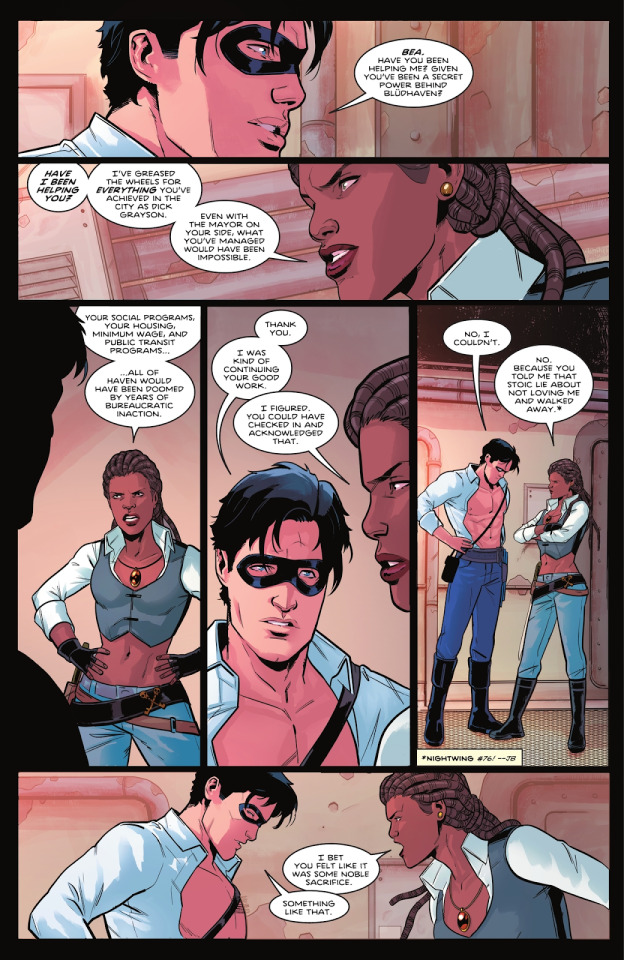
(Taylor, Tom, writer. Byrne, Stephen, illustrator. The Crew of the Crossed Part Three. Nightwing: Rebirth. 107, e-book ed. DC Comics, 2023. pp. 06)
Ordinarily, I wouldn’t consider that to be much of a problem. After all, the reason why Detective Comics and Batman comics do not focus on Bruce’s philanthropy is because that is not the focus of those stories (Though I once more feel the urge to note that Cataclysm and No Man’s Land managed to incorporate such elements into the main plot while still keeping the focus on the gang wars, superhero work, and detective investigation). But Taylor made The Alfred Foundation and Haven a centerpiece of the beginning of his run. In his attempts to address the popular online discourse about Bruce’s money being a solution to Gotham’s problem, Taylor made the idea that Bludhaven needed Dick Grayson’s philanthropic efforts to be their safety net a main theme of his story. For that reason, this plot element should have been a major focus, which means it should have been a main source of conflict in ways that showed just how Blockbuster’s cruelty affected the disposition of Bludhaven’s citizens.
The absence of conflict and tension in the story point that is so pivotal to Taylor’s run demonstrates not only Taylor's underwhelming abilities as a writer, but also how he approaches writing not with a focus on storytelling, but rather with a focus on online discourse. Scholar Steve Braxi highlights this as one of the main problems in Taylor’s writing when examining both Nightwing and Superman: Son of Kal-El in the essay On Superman, Shootings, and Realities of Superheroes. There, Braxi dismantles criticisms against the “socio-political” responsibilities of fictional superheroes by arguing such critiques to be in bad-faith for demanding “political solutions from fictional realities.” According to him, in these arguments, “Superman and Batman are not treated here as ideas readers want to believe in, but rather people that need to prove their worth to us. They need to take on real issues in their fictional world in order for their fictional solutions to speak to our real world. This equivalency between their world and ours has a dissonant effect on me because I think it misunderstands the entry point of fiction in the first place.” (Braxi, Steve, “On Superman, Shootings, and the Reality of Superheroes” Comics Bookcase, September 2021)
Taylor’s decision to make Dick a billionaire who uses his money for the social benefit of others is a response to popular online discourse about whether Bruce Wayne should use his money to help Gotham in ways other than Batman. While I already pointed out that such arguments ignore the fact that Bruce does, canonically, use his wealth to the benefit of others, Braxi points out that “the argument that Superman ignores real social issues or that Batman is worse than the crime he fights does not assume the best intentions of the characters, creators or nature of fiction. They engage with these stories from a perspective that is intentionally distant from the unique reality of the story being told.” (Braxi, Steve, “On Superman, Shootings, and the Reality of Superheroes” Comics Bookcase, September 2021)
Braxi rightfully argues that attempts to respond to shallow criticism leads to shallow storytelling. It is only because these are popular online arguments that Taylor makes them important plot points in his story. And yet, despite their supposed importance, the Alfred Pennyworth Foundation and Haven are not properly incorporated into the story because Taylor does not take into consideration what these elements say about his characters, his themes, and how they can shape the plot on a deeper level. As such, the lack of meaningful conflict can be seen as a symptom of this thoughtlessly performative desire to play into trendy discourse. Character complexity, narrative depth, and thematic cohesion are all sacrificed to please an ever changing social media algorithm and debates that are forgotten and disregarded in a matter of days.
Even the Alfred Pennyworth Foundation’s name is, quite frankly, evidence of such online fan pandering at the cost of characterization and narrative. Alfred is beloved by many, and while we do not have time to discuss DC’s attempts to sanitize his character after his death (While I adore Alfred, he had many flaws that affected the manner in which he raised Bruce and Dick. These flaws, however, have been ignored or erased by current comics that prefer to portray Alfred as a benevolent father figure who never made any mistakes. While I believe Bruce and Dick would glorify Alfred in such a manner, that does not mean the narrative has to agree with their biased perspectives),
the reality is that though Alfred may mean a lot to Dick Grayson fans, he means nothing to the people of Bludhaven. From my personal point of view, Alfred was also not the type of person who would have liked to have a statue in his honor in a city he never visited. From an in-universe perspective, naming a nonprofit meant to help the people of Bludhaven after a man who did not even live in their city and then erecting a statue in his honor makes no narrative sense. But Taylor does it because the statue means something to the audience, regardless of how that would play in-universe.
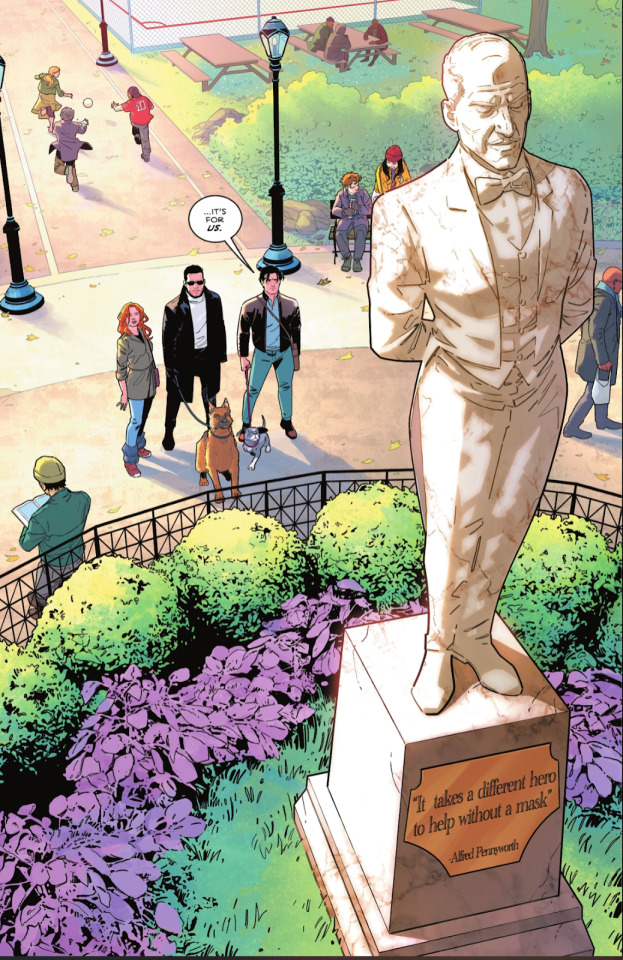
(Taylor, Tom, writer. Redondo, Bruno, illustrator. The Battle for Bludhaven’s Heart. Nightwing: Rebirth. 92, e-book ed. DC Comics, 2022. pp 12)
Furthermore, by not having Dick interact with the people of his city, Taylor contradicts his supposed characterization of Dick as a “good guy.” This is yet another instance of telling and not showing, and it is most obvious when looking at Heartless.
Though Taylor tried to build up Heartless as this intimidating villain, he put little effort into matching said intimidation with the appropriate amount of urgency. Dick does not treat Heartless as an actual threat. This, as mentioned previously, transforms Dick into a self-absorbed man who does not understand (or does not care) about dangers being posed to the people of his city.
From both a narrative and a character standpoint, the fact that the children of Heartless’ victims mirror Dick’s own experience makes this disconnect even more frustrating.
Dick lost his parents. He knows what it feels like to see their dead, bloody bodies on the floor when you’re but a small child. Dick also knows how finding justice can help with closure, and how not finding justice can haunt you for the rest of your life. Knowing that Heartless made countless kids into orphans should be a crucial motivation for Dick to fall into that intense and obsessive pursuit that characterizes his crime fighting. Dick should be working on this case constantly, for he knows what those kids are going through. Dick appointed himself their protector, yet he does nothing for them. He does not guide them through their grief the way Bruce did for him, he does not find justice for their parents the way Batman and Robin did when they captured Zucco, he does not offer them closure or an outlet for their anger and their pain. The story does not show Dick to be a hero, but rather, it makes him into an incredibly selfish, lazy person who is only interested in the optics of heroism, and not the, often thankless and unacknowledged, work it takes to actually help people.
The contrast between how Dick is Nightwing: The Untouchable and Taylor’s run could not be greater. The former carried every death on his shoulders, determined to push through bullet wounds in order to prevent more killings. The latter behaves as if Heartless did not exist unless he is on screen.
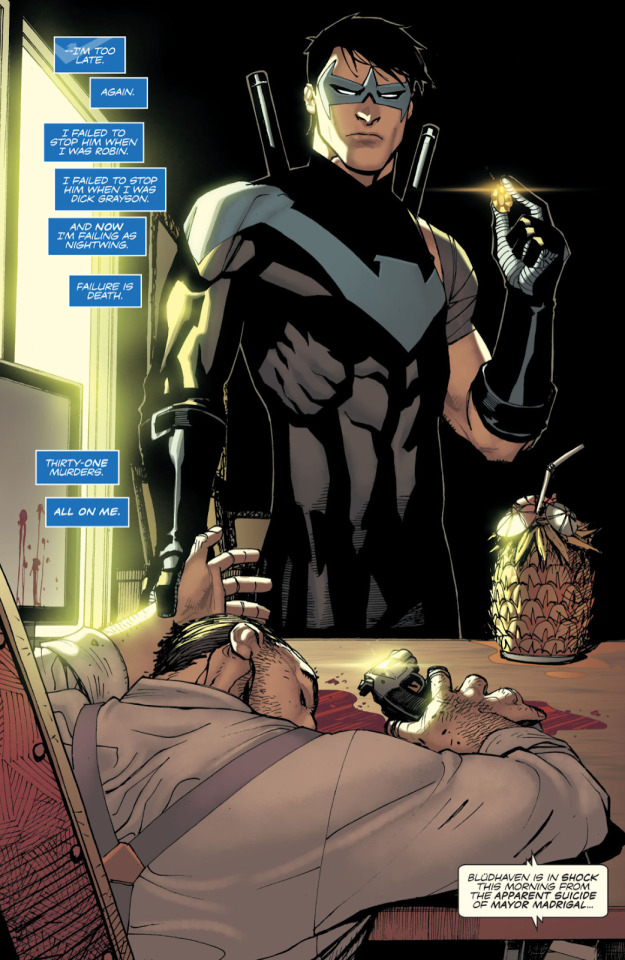
(Humphries, Sam, writer. Chang, Bernard, illustrator. The Untouchable: Chapter Two: Relentless. Nightwing: Rebirth no. 36, e-book ed. DC Comics, 2018. Page 20)
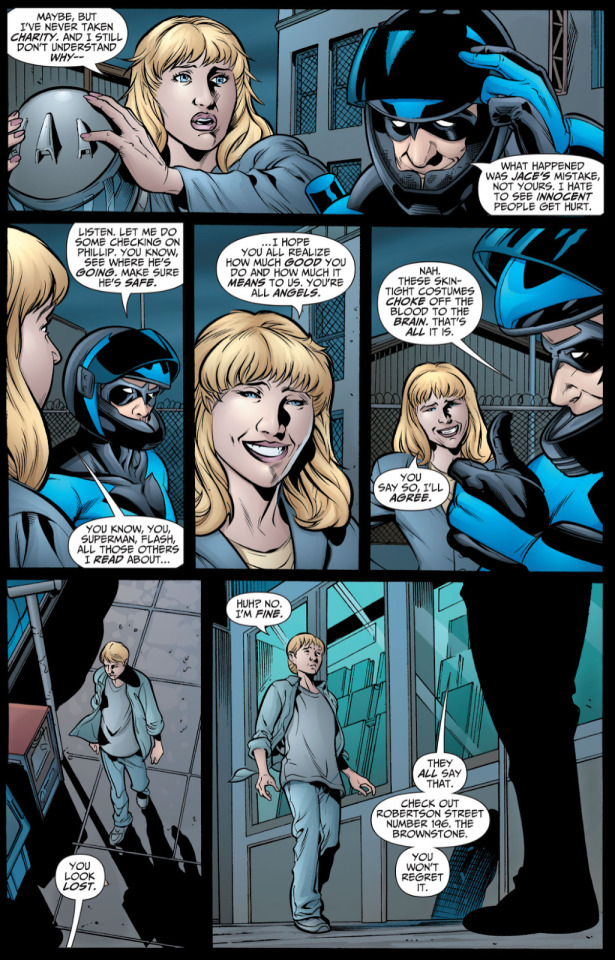
(Wolfman, Marv, writer. Igle, Jamal, illustrator. Bride and Groom: Part One: The Courtship. Nightwing no. 129, e-book ed. DC Comics, 2007. pp. 11)
That is because Wolfman understood that the best way to show Dick’s compassion was to have him interact with those whose lives were made better by his presence. As readers, we were able to experience first-hand the difference Dick makes on an individual and personal level. This is more than just having Nightwing appear in a pencil case; this shows Dick actively interacting with the people of his city, forming genuine connections with them, and putting in the work to make their lives better because he cares.

(Wolfman, Marv, writer. Luque, Paco Diaz, illustrator. Bride and Groom: Part Four. Nightwing no. 132, e-book ed. DC Comics, 2007. pp. 24)
Please understand that I am not saying that Heartless should be present in every single issue, from the moment he was introduced to the moment he is finally caught. But just because he is not physically there, it does not mean that the story should not be exploring the effect his actions have on his victims' loved ones. Readers should see the terror that grips Bludhaven as a serial killer is on the loose. How do people, especially the homeless youth Dick vowed to protect, react when they don't feel safe? Heartless doesn't need to be physically there, but his presence and its effect should still be felt. That's what happened with Blockbuster in Nightwing (1996) – he may not have been there all the time, but his grip on Bludhaven, on the corrupt systems, on Dick's life, was still always present.
By depicting Heartless’ effect on Bludhaven would not only add urgency and stakes to the plot, it would give faces to his victims while giving Dick the opportunity to bond with the people of Bludhaven. Perhaps as Heartless’ orphans come together in their grief and anger, and once they realize that the corrupt BCPD isn’t going to bring justice to their parents, they decide to take matters into their own hands. Then Nightwing could step up and prevent them from going too far. He could teach them productive ways to channel their anger, give them shelter and an empathetic ear, and he would vow to do right by them when no one else did before. This would show Nightwing’s love for Bludhaven and it would bring the themes of inequality and social justice that Taylor claims to want to explore into the narrative in a more emotionally effective manner, for the homeless youth would have names, faces, and their own voices.
There doesn’t even need to be many children. In fact, there could be just one — Elliot, from #79.
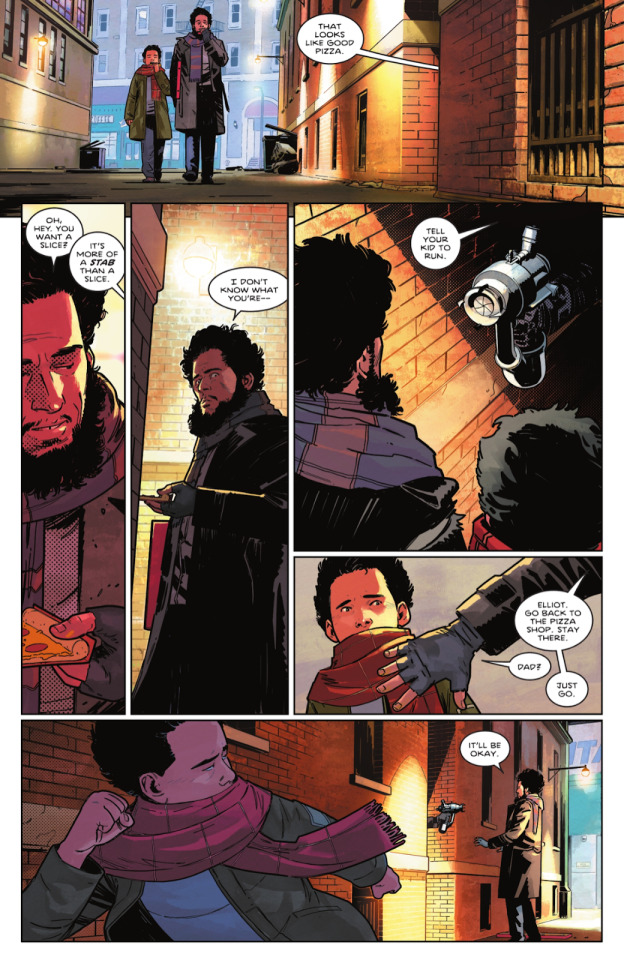
(Taylor, Tom, writer. Redondo, Bruno, illustrator. Leaping into the Light Part Two. Nightwing: Rebirth. 79, e-book ed. DC Comics, 2021. pp 11)
By making Elliot the face of Heartless’ true evil, the face of the victims of Bludhaven’s corrupt system, of people’s lack of compassion, Taylor would show the reader everything Dick wants to fix in Bludhaven and why it needs fixing. Elliot would humanize these abstract concepts so that the reader is emotionally invested in Dick’s success. The stakes are suddenly personal. Furthermore, it would prevent the city from feeling so barren while giving Dick people to care for outside of his already established connections. Just as Bruce did with him, Dick could see much of himself in Elliot, and that would lead him to want to help Elliot in a similar way Bruce helped him all those years ago. This also would have contributed to making the hug in #100 more effective, as it would be creating mirrors and parallels between Bruce and Dick’s relationship, and Dick’s relationship to Elliot.
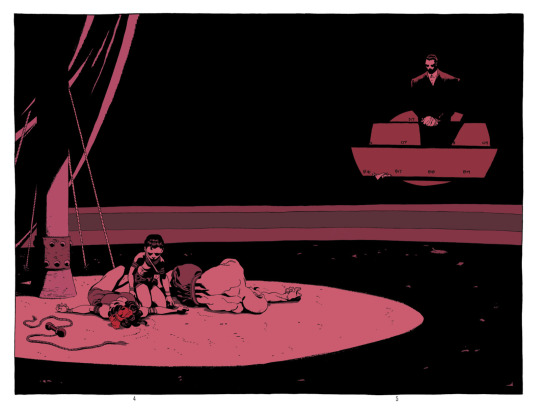
(Loeb, Jeph, writer. Sale, Tim, illustrator. Orphans. Batman: Dark Victory. 09, e-book ed. DC Comics, 2000. pp 05)
The fact that it took over thirty issues for Taylor to finally, finally, draw a connection between Bruce, Dick, and Heartless victims in #111 is, frankly, lazy and thoughtless.
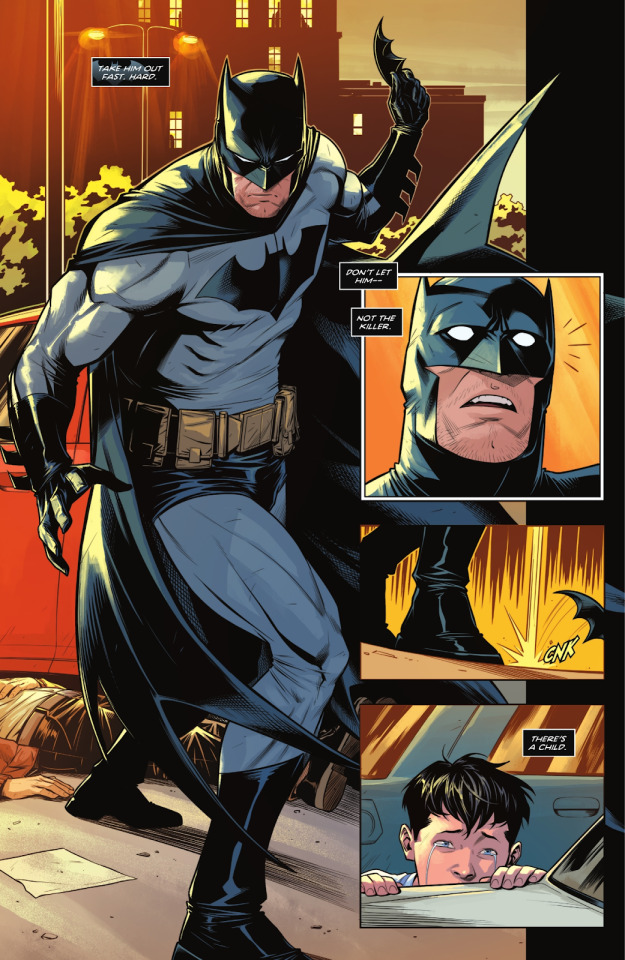

(Taylor, Tom, writer. Basri, Sami, illustrator. Nightwing. Nightwing:Rebirth. 111, e-book ed. DC Comics, 2024. pp 05-06)
In his 2022 video titled The Secret Ingredient That Makes Raimi's SPIDER-MAN So Great (Season Premiere), video-essayist and film critic Patrick H Willems discusses how vital of a role the ordinary citizen characters played in the Sam Sami Spider-Man trilogy. He describes how “they make the New York of these movies feel like a real, thriving city populated by a vibrant community of characters. Because if we’re going to care about Spider-Man caring about the people of New York, we have to actually get to know the people of New York.” (Willems, Patrick H. “The Secret Ingredient That Makes Raimi's SPIDER-MAN So Great (Season Premiere)” Youtube, uploaded by Patrick (H) Willems, 20 September 2022 https://www.youtube.com/watch?v=xFpQBOopf84)
Similarly, giving Bludhaven citizens, giving Heartless’ victims agency and individuality would have elevated the story and made Dick into a more empathetic and endearing hero. We would have cared about the people of Bludhaven because we would have gotten to know them through their interactions with Dick.
But to accomplish that, Taylor would have to actually care about who Dick Grayson is and who the people of Bludhaven are; he would need to actually care about the story he is trying to tell as a whole, rather than simply writing for moments that will merely appear progressive when removed from their context and presented on social media.
To be perfectly fair to Taylor and Redondo, they are hardly the only ones to miss an opportunity when it comes to Bludhaven. Even Dixon and Grayson, the first two who were given the chance to breathe life into this city, were satisfied to treat Nightwing’s abode as merely “Gotham lite.” In fact, much could be said about DC’s handling of Bludhaven, its lack of investment in the city, the ways in which it tried to erase it from its history, and what parallels can be made with how many in DC view Dick Grayson. What sets Taylor and Redondo’s mishandling apart from all others was that, instead of depicting Bludhaven as a generic corrupt city, they opted instead for a gentrified, picturesque liberal urban utopia. As Taylor’s Nightwing perfectly said when confronting Blockbuster, Roland Desmond is the one big identifiable bad guy who is shown to be the source of all of Bludhaven’s problems.
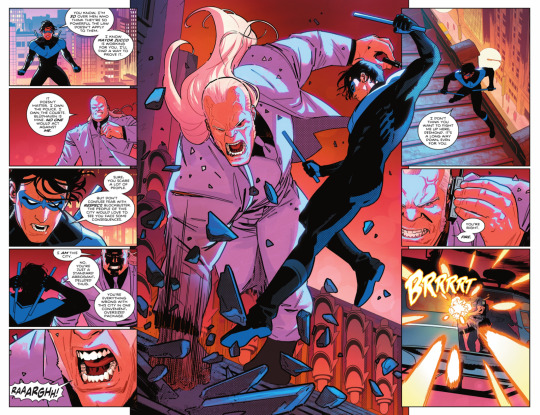
(Taylor, Tom, writer. Redondo, Bruno, illustrator Leaping into the Light Part Six. Nightwing: Rebirth. 83, e-book ed. DC Comics, 2021. pp. 08)
Like Gotham, Bludhaven is broken in a myriad of ways. While many of their problems come from those on top, both cities also face mundane evils that rise from not just suffering, but apathy. There are many stories about Gotham that explore the dark and the light side of humanity, acknowledging that both of them can be found in us. It was a small evil that killed Thomas and Martha, but it is a grander, structural evil that prevents justice from being served and hinders Gotham from prospering. It was also a grander, structural evil and corruption that put Joe Chill in a position where he held a family at gunpoint and murdered a mother and father in front of their young child.
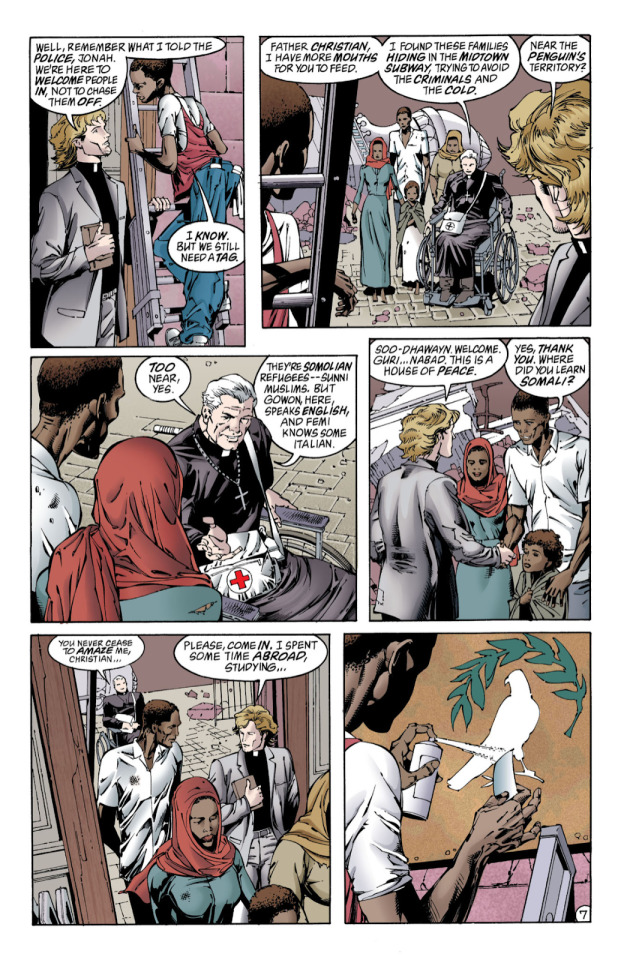
(Grayson, Devin, writer. Eaglesham, Dale, illustrator. Fear of Flames Part One: Fanning the Flames. Batman: Legends of the Dark Knight. 116, e-book ed. DC Comics, 1999. pp. 07)
Bludhaven is often characterized as Gotham’s little sister. In fact, it was the fact that the city reminded Dick so much of a Gotham without a Batman or a Gordon that Dick decided to take on the challenge of caring for Bludhaven. He saw a city in need, knew he could do something to help it, and so he did.
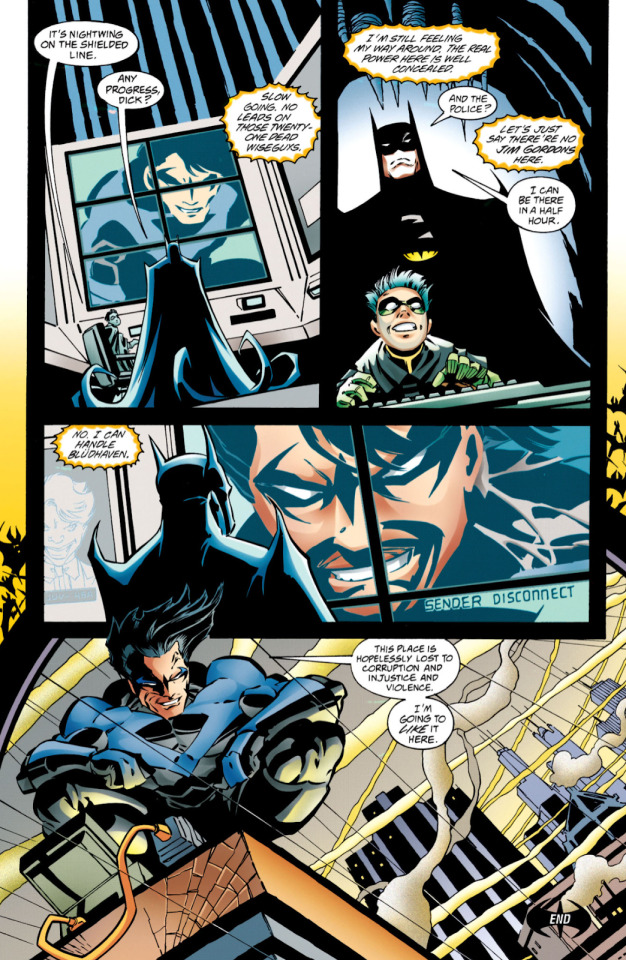
(Dixon, Chuck, writer. McDaniel, Scott, illustrator The Freebooters. Nightwing. 03, e-book ed. DC Comics, 1996. pp. 23)
Just Batman struggles in No Man’s Land when there is no system to uphold, the beginning of Dixon’s run is characterized by Dick struggling with the lack of allies or of a network in which he could trust. As Tim pointed out to him in Nightwing #06, Dick was all on his own.
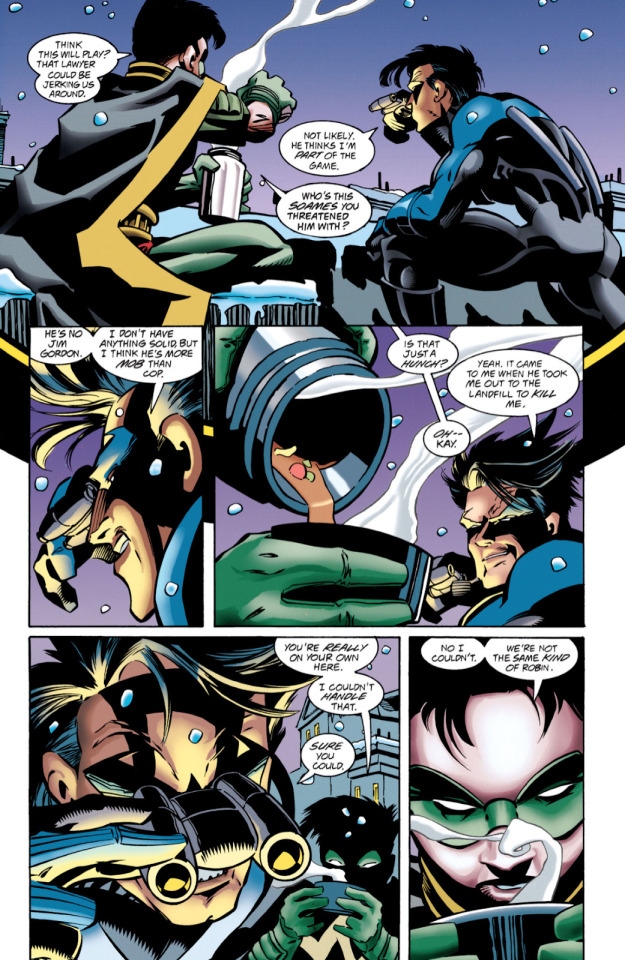
(Dixon, Chuck, writer. McDaniel, Scott, illustrator The Visitor. Nightwing. 06, e-book ed. DC Comics, 1996. pp. 12)
Tim Seeley also emphasized this isolation in his run, though in this scenario, Dick purposefully sought out this separation in hopes that being in Bludhaven would help him discover who he is.
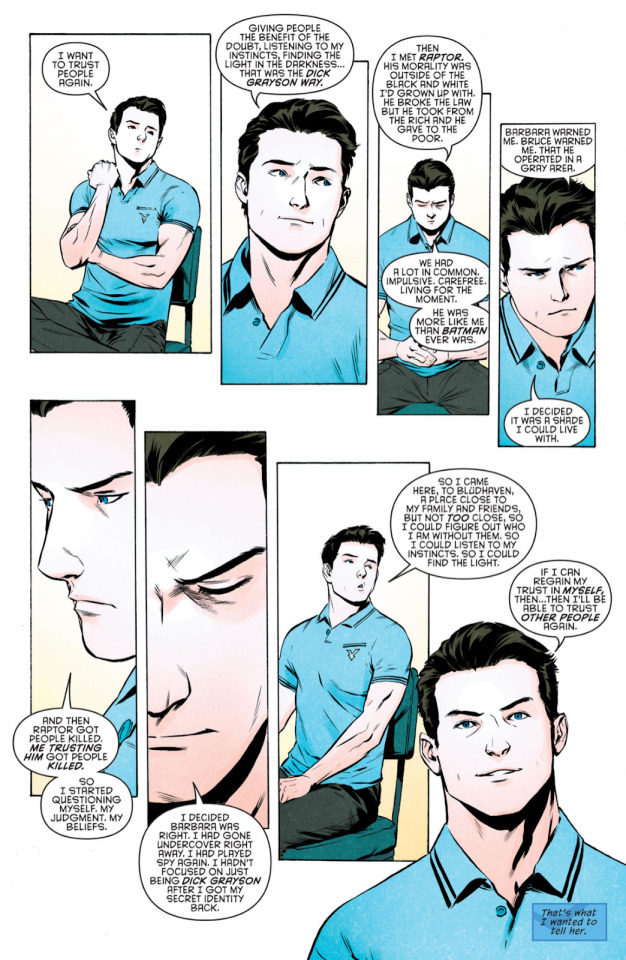
(Seeley, Tim, writer. To, Marcus, illustrator Bludhaven: Part One. Nightwing: Rebirth. 10, e-book ed. DC Comics, 2016. pp. 08)
As both runs progress, Dick slowly builds his own network of alliances. In Dixon’s run, which seems to be the one that, given Blockbuster’s presence, most inspired Taylor, Dick learns how the city operates and crafts a strategy that balances tackling emergencies, disrupting the system, and slowly untangling the messy rot beneath without causing unforeseen negative consequences.While Dixon’s run is filled with problematic elements in its own right (especially when it comes to the portrayal of women and even some aspects of Dick’s characterization), this section will be focusing on how the narrative provides opportunities for Dick to interact with the ordinary people of Bludhaven. (Taylor drawing inspiration from Dixon’s run can be observed not only on the similarities between the plot points [though he retreads mainly Grayson’s run rather than Dixon’s], but also by Taylor’s own admission. In February 2024, when Dixon posted a homophobic tweet about Jon Kent and Dick Grayson, Taylor expressed his disappointment over Dixon’s attitude and cited how Dixon’s run was an inspiration to him.)
Clancy becomes a bridge between Dick and his neighbors, who represent different facets of Bludhaven.
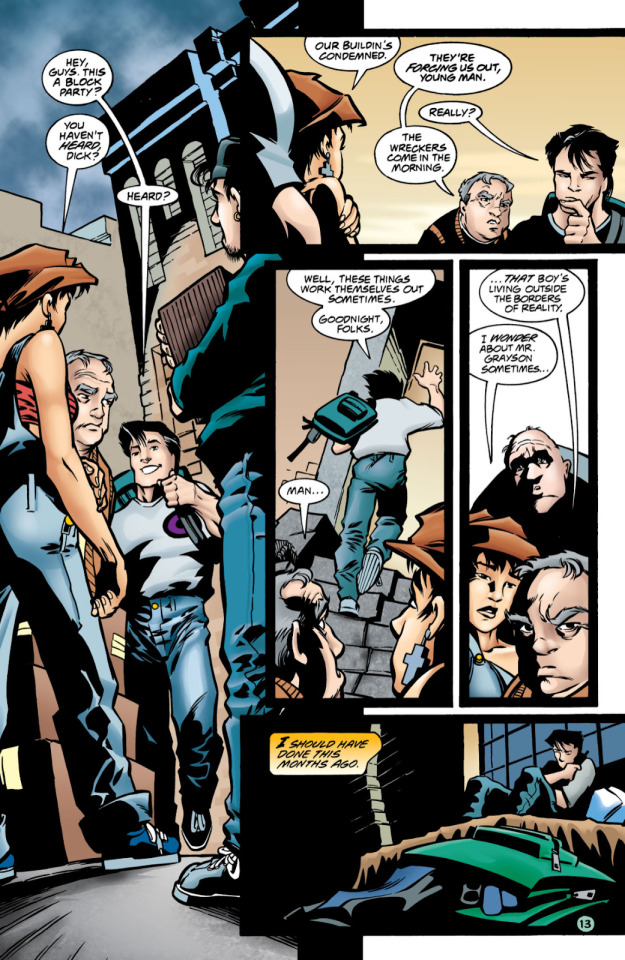
(Dixon, Chuck, writer. McDaniel, Scott, illustrator. False Starts. Nightwing. 21, e-book ed. DC Comics, 1998. pp. 13)
Through his work as a bartender he gains insight into cold cases, learns more about the Bludhaven City Police Department.
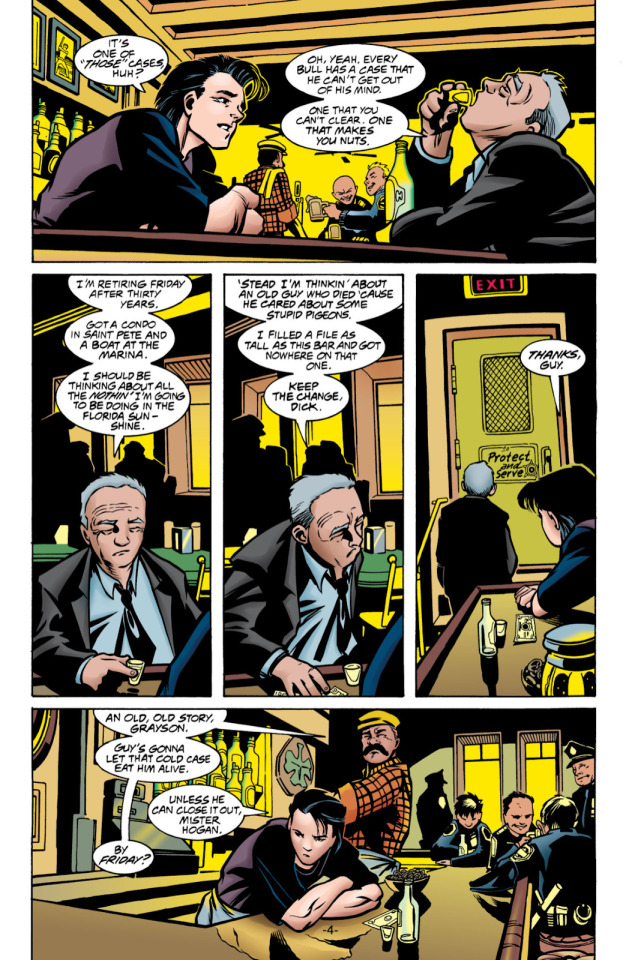
(Dixon, Chuck, writer. McDaniel, Scott The Forgotten Dead. Nightwing. 24, e-book ed. DC Comics, 1998. pp. 24)
He befriends his partner Amy Rohrbach, and with her, he learns about the small alliance of clean cops that are trying to overthrow the current dirty officials.
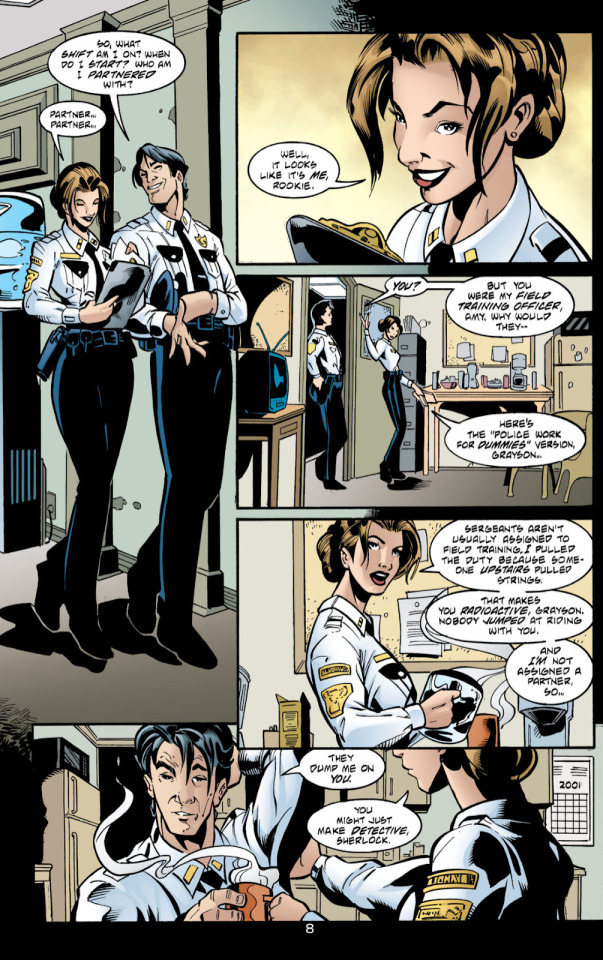
(Dixon, Chuck, writer. McCarthy, Trevor, illustrator. The Threshold. Nightwing. 60, e-book ed. DC Comics, 2001. pp 08)
Similarly, Grayson's run shows us the complicated politics of the city’s underworld, presenting the reader with a myriad of characters. While Dick certainly encounters greedy mobsters interested only in using violence as a means to gain wealth
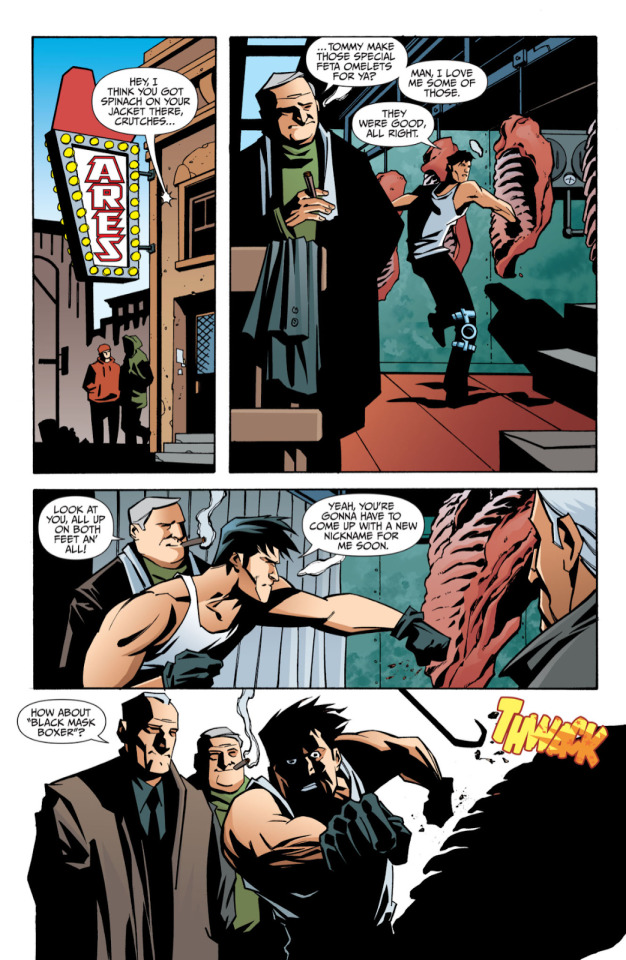

(Grayson, Devin, writer. Hester, Phil Cold Turkey. Nightwing. 109, e-book ed. DC Comics, 2005. pp. 11 - 12)
Dick also interacts with those who ended up caught up in such a dark world through no fault of their own. When Dick, acting as Crutches, beats up a mobster, he discovers his innocent girlfriend and the girlfriend’s child were in the house. While Dick, as our hero, did not allow any harm to come to them, the trauma they went through is not ignored by the narrative.
In fact, not only is it acknowledged, but when Angie Malazavos comes to the police with information on the mob — something that could only happen thanks to Dick and Amy successfully removing a majority of dirty cops from position of power — we see that trauma repeated as the police raids the house of the mobster who began the attack.
Memorably, this leads to Sophia Tevis, the fifteen year old daughter of said mobster, to not only become an orphan, but embody that uncomfortable synthesis of crime and innocence after she witnesses her entire family — a family who loved and doted on her — being killed by the police
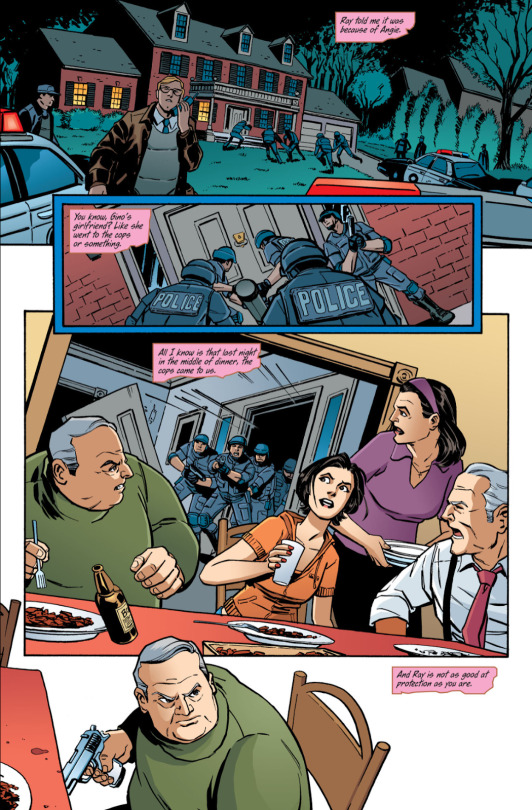
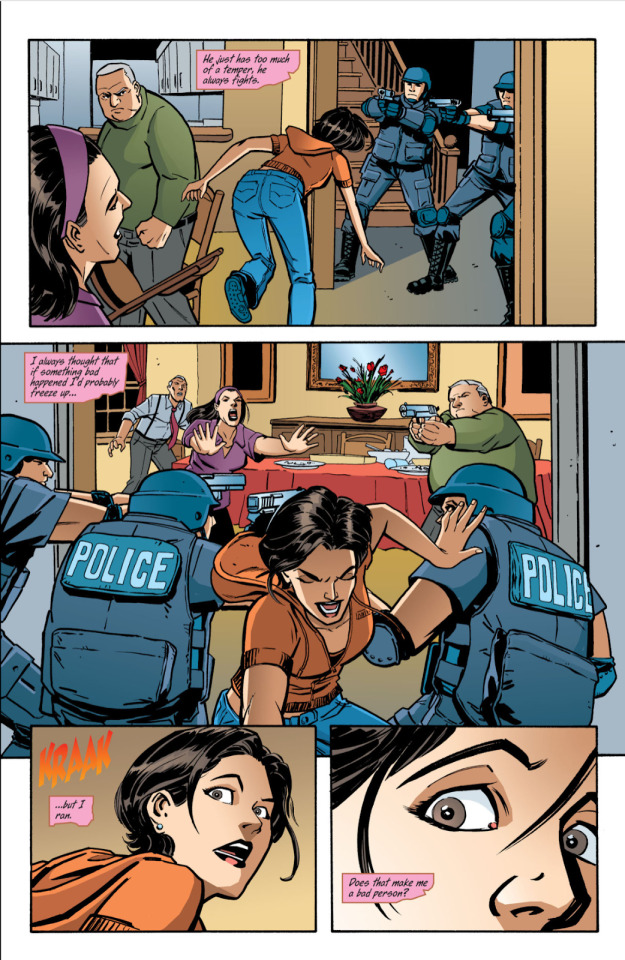
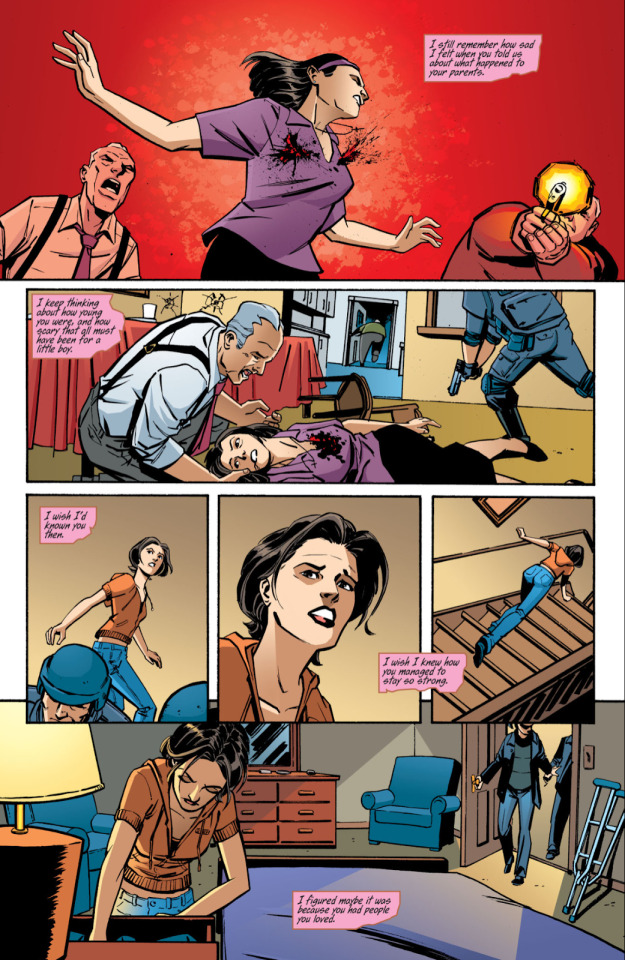
(Grayson, Devin, writer. Chiang, Cliff, illustrator. Signed, Sophia. Nightwing. 111, e-book ed. DC Comics, 2005. pp. 5 - 7)
As he takes her under his wing, Dick and the reader are forced to confront the unclear position people like Sophia occupy in a world that attempts to create clear divides based upon not only actions and motivations, but relations.
By contrast, Taylor’s Bludhaven is too… Nice. Like his characters, it lacks any substance or personality, being a shallow and bland setting without true flaws or appeal. By blaming Blockbuster and his cronies for all that is wrong in Bludhaven, Taylor cheats himself of the opportunity to give Bludhaven flavor. He creates a world where either you are a rich man taking advantage of others or you are a helpless victim who has a good heart and will always be selfless.
This simplistic morality and the surface-level portrayal of Bludhaven as a city not only proves that Taylor gives the city he is writing about no true thought, but it also shows how Taylor’s supposed interest in progressive messages and socially-conscious themes is an incredibly shallow one. After all, if Taylor truly wanted to explore themes of class inequality and systematic injustice, then such a simplistic moral approach works against the innate human messiness and structural complexities inherent in these themes. It is not the themes or its messages, therefore, that interest Taylor, but rather the prestige that comes from being viewed as someone writing about these issues.
This once more shows that Taylor does not care about the story he is telling, the characters in his care, the themes he brings up, and the city whose legacy is in his power to shape. He is not approaching his run from the perspective of a writer, but rather, of a person who chases clout on social media.
As Braxis pointed out in his article, engaging with these themes is difficult. Engaging with it well — truly entering the conversation about real world political, social, and economic problems — is even more so, especially when you also have to tell a satisfying story that does come across as preaching. More than that, though, a story that so directly confronts these issues must, in order to be effective, force the reader to come to terms with their own culpability in a system that is far larger than the individual. It must force us to be uncomfortable and have us ask ourselves how we can bring on change, even in some small way. If such stories are not willing to have the reader be truly emotionally uncomfortable, then they are simply appropriating the pain and suffering of others for a bit of socially progressive coat of paint.
Taylor does not want his readers to be uncomfortable. He does not wish to upset them. He does not wish them to worry or even feel the slightest bit of tension by having Dick be wrong or someone say something mean. He refuses to portray all the many ways evil can manifest in society, all of the petty cruelties everyday people inflict on each other, the apathy of those who are comfortable, the way many must force themselves into individualistic selfishness in order to survive or in order to protect those they love. Taylor doesn’t allow for the pettiness in his world, where, in #87, even a random passerby must happily offer up his bike to Nightwing without questions or expectations.
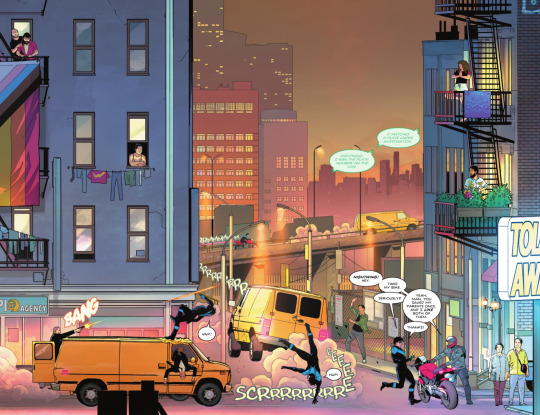
(Taylor, Tom, writer. Redondo, Bruno, illustrator. Get Grayson. Nightwing: Rebirth. 87, e-book ed. DC Comics, 2021. pp 08)
Taylor’s depiction of Bludhaven betrays a very juvenile idea of what good and evil means, a very simplistic idea of how the world works, and very easy solutions to fixing difficult problems, with all of the woes being “fixed” when good guys like Dick, Babs, and Melinda are in power. If you are not one of the main characters, then you are either a corrupt criminal using their money to take advantage of people, or you are a poor helpless victim. There’s no in between, no space for the mundane evils of the world or the average heroics of average people.
As Braxis pointed out when discussing the superficiality of Taylor’s social critique: Son of Kal-El and Nightwing demonstrate a pattern in Tom Taylor’s writing where social issues are used as plot devices, but there is a performative contradiction this ends up creating. Jon and Dick are exposed to social issues as a gateway to criticize their mentors. However, their lack of understanding about the issues they’re exposed to means their own criticisms can be thrown back at them.
(Braxi, Steve, “On Superman, Shootings, and the Reality of Superheroes” Comics Bookcase, September 2021)
Please note that I'm not saying that exploring class inequality and systematic injustice aren’t interesting lenses through which one can explore Bludhaven. However, by making Bludhaven such a friendly yet passive city, Taylor stumbles onto a trap of his own making. He uses no metaphors, no allegories, no symbolism, no fantasy or science fiction elements to create distance between the narrative and the real world, allowing more freedom with how these topics could be discussed. Taylor decided to tackle, as Braxis characterized, “shallow criticism, a criticism in bad faith” by directly engaging with these real world problems, and as such, he took on work that was not only far beyond his capabilities as a mediocre writer, but work that he clearly has no interest in undertaking.
To have to read about this Bludhaven after we had Humphries and Chang’s depiction feels even more like a knife to the heart of every Dick Grayson fan.
Humphries’ The Untouchable, Bludhaven’s corruption and evil is beyond “generic” police corruption. It is specific. It is unique. Bludhaven has a history. It has personality. Humphries’ run touches on themes of corruption both through the fantastical use of the Judge, and by the very specific scenario of Bludhaven’s unique economic problems. This Bludhaven’s economy is so deeply tied to a rotten, corrupt system that everyone ends up being both victim and perpetrator. The system harms all of them, but without it, they cannot survive.
The casinos were corrupt, stealing money from schools, lining its owners pockets, controlling the mayor through bribery and blackmail. But Bludhaven is also dependent on the casinos. Its economy is entirely dependent on them to the point that even those who do not work directly with the casino still need them to thrive. This creates a fascinating and complicated scenario where weeding out the corruption that led to so much suffering will not solve anyone’s problem. In fact, as the story demonstrates, it can even make it worse.

(Humphries, Sam, writer. Chang, Bernard, illustrator. The Untouchable: Chapter Two: Relentless. Nightwing: Rebirth no. 36, e-book ed. DC Comics, 2018. pp. 21)
For a more concrete example of how Humphries and Chang were able to flesh out Bludhaven in five issues so much more than Taylor and Redondo did throughout all these years, I want to compare Humphries’ handling of the Justice Tree with Taylor’s handling of the Octopus statue in the beginning of his run.
Humphries’ Justice Tree not only creates a concrete and identifiable landmark within the city, not only is it connected to Bludhaven’s history, The Untouchable’s main antagonist, and Dick’s personal relationship with the city, but it is also tied to the themes of the plot.
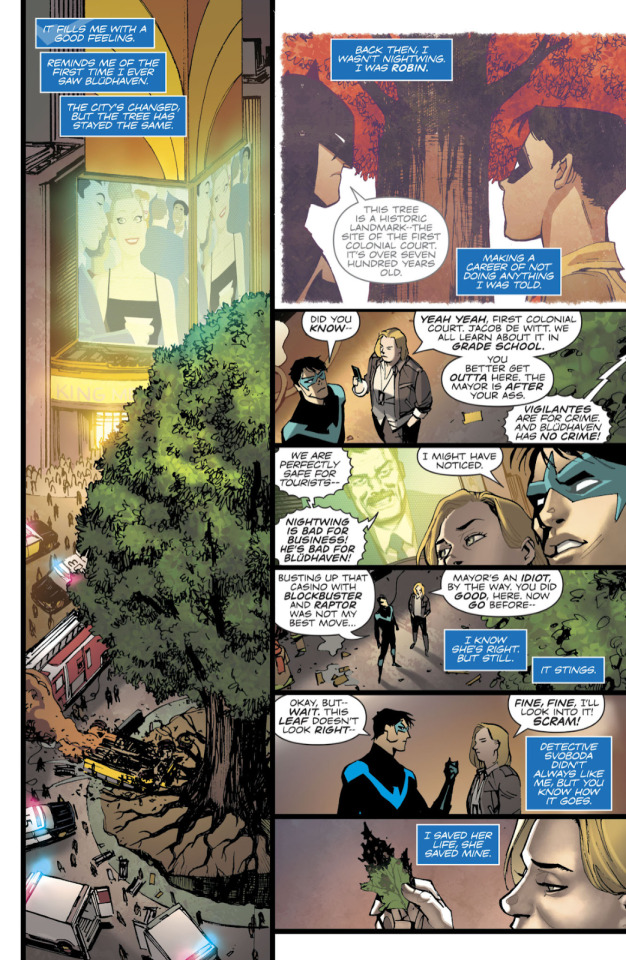
(Humphries, Sam, writer. Chang, Bernard, illustrator The Untouchable: Chapter One: Hunter. Nightwing: Rebirth no. 35, e-book ed. DC Comics, 2018. pp. 12)
In The Untouchable, the Justice Tree is rich with symbolism. First planted in Bludhaven by The Judge while he was still human, symbolizes, well, justice. As the Judge’s return and his machinations reveal the rot that had been seeping into Bludhaven, the tree begins to wither, its centuries old existence threatened. As the tree’s fate is at risk, so is Bludhaven’s.
The narrative goes back to the Just Tree just at the right beats, emphasizing the thematic core of its story. It also contributes to the plot by becoming a ticking clock. It’s threat countdowns to the big climax of the story, when Nightwing and the Judge will battle for Bludhaven’s soul. It is notable that while the Justice Tree was first planted by the Judge, it is Dick’s efforts that manage to save it, so even though both men are fighting for what they believe to be right, everything about narrative indicates that Dick is the one who ultimately has what it takes to save Bludhaven from corruption.
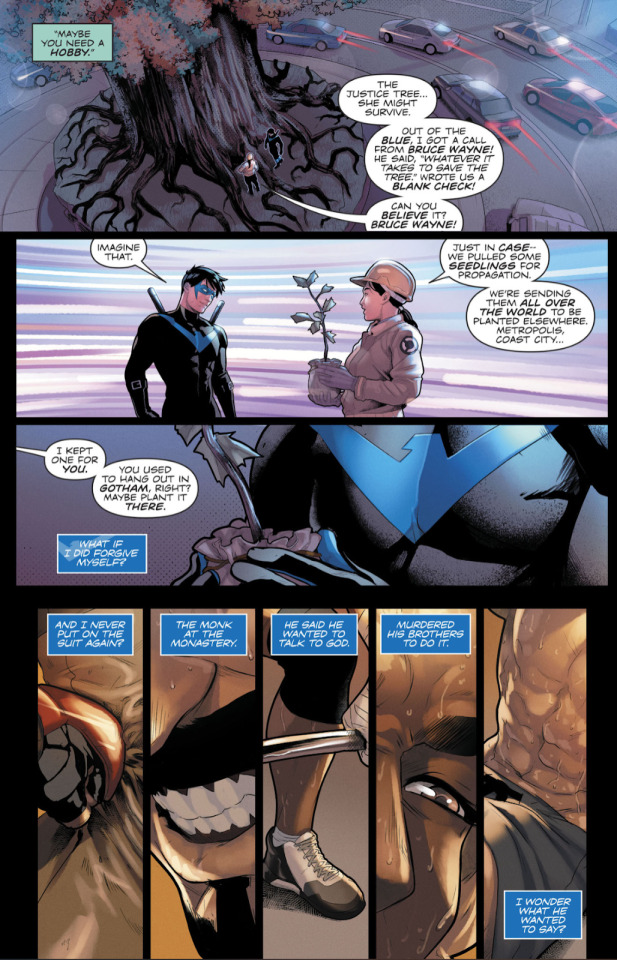
(Humphries, Sam, writer. Chang, Bernard; Campbell, Jamal, illustrator. The Untouchable: Chapter Seven: Final Judgment. Nightwing: Rebirth no. 41, e-book ed. DC Comics, 2018 pp. 22)
That being said, another big theme of this story is forgiveness and kindness, two principles that are essential to Nightwing. Dick emphasizes that no one should be judged by their actions when they are at their worst, so long as they decide to move forward and do good.

(Humphries, Sam, writer. Chang, Bernard; Campbell, Jamal, illustrator. The Untouchable: Chapter Seven: Final Judgment. Nightwing: Rebirth no. 41, e-book ed. DC Comics, 2018. pp. 21)
And yet, Dick is unable to extend this same kindness to himself. While he is able to forgive everyone around him for giving into the Judge’s temptations, he is unable to forgive himself for being unable to stop the Judge sooner.
These themes are embodied in the Justice Tree, which is threatened when the Judge is at large, and then is given a chance of salvation when he is captured by Dick and he is able to convince Bruce to invest in the efforts to keep the tree alive. The story concludes with Dick being given a piece of it to plant wherever he chooses (and he chooses close to his home, to Nightwing’s headquarter, the perfect marriage between Dick Grayson and Nightwing).
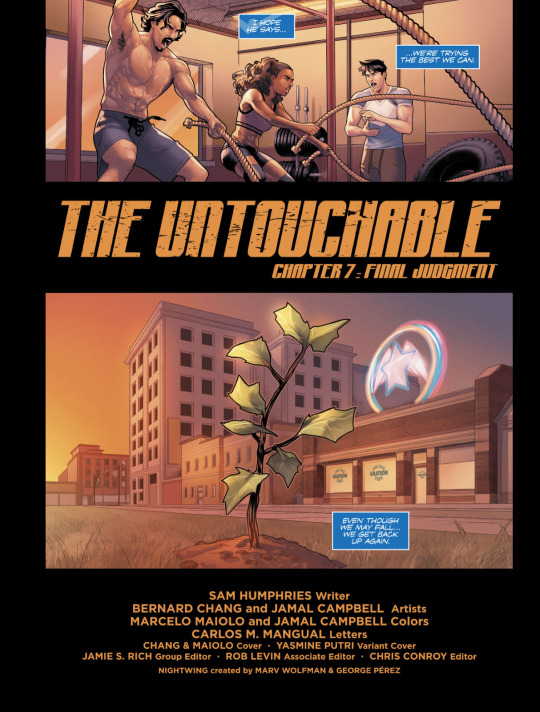
(Humphries, Sam, writer. Chang, Bernard; Campbell, Jamal, illustrator. The Untouchable: Chapter Seven: Final Judgment. Nightwing: Rebirth no. 41, e-book ed. DC Comics, 2018. pp. 23)
And that is not even to mention the way the art manages to convey so much. The tree that symbolizes justice is surrounded by the corrupt casinos. Nature is surrounded by artificial neon lights, circling in it, caging it so that it cannot branch out, cannot expand, cannot grow. The more natural, soothing colors of the tree contrasted against the bright neon colors of Bludhaven. The sharp lines of the tree vs the blurriness of the city. All of it visually conveys the main conflicts of the story that work together with its themes.
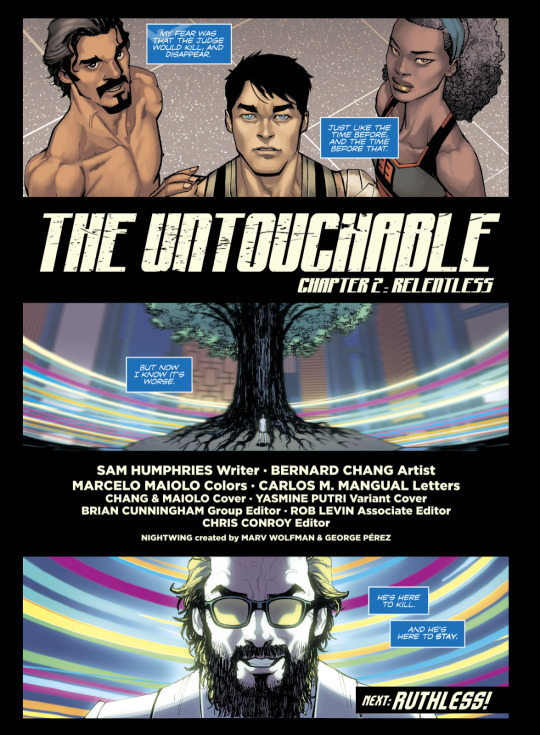
(Humphries, Sam, writer. Chang, Bernard, illustrator. The Untouchable: Chapter Two: Relentless. Nightwing: Rebirth no. 36, e-book ed. DC Comics, 2018. pp. 22)
By contrast, Taylor’s depiction of the Octopus Statue feels… Lacking. When looking at it with Babs, Dick ruminates on the history of Bludhaven and how it symbolizes Bludhaven’s resilience. He connects it to the city’s history and to how the people of Bludhaven can overcome even the most difficult challenges. In doing so, Dick also asserts his mission statement — he wants to be the safety net for these resilient people, he wants to be their protector, he wants to prop them up, to give them someone to rely on so they won’t feel abandoned.
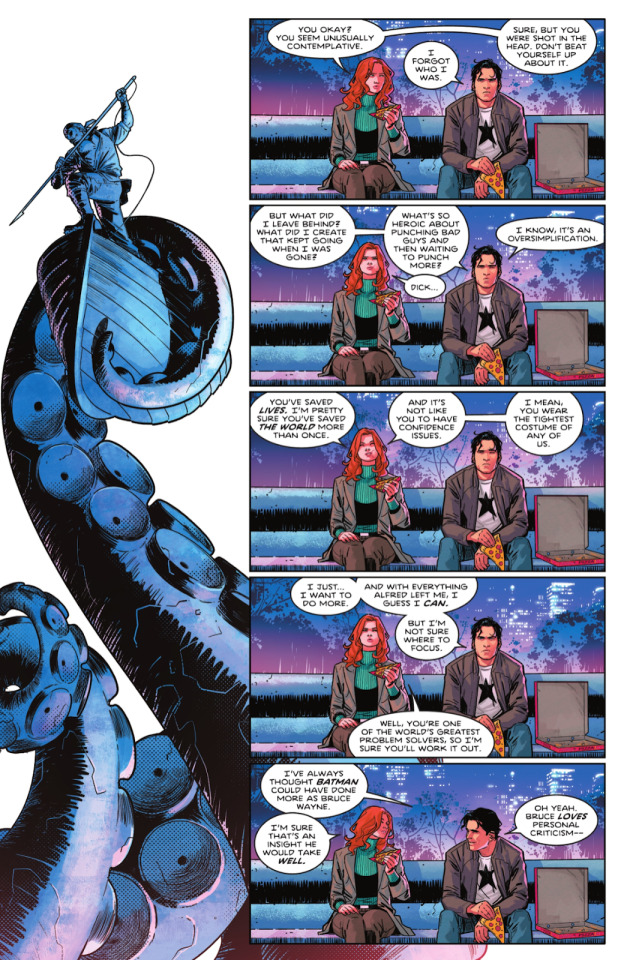
(Taylor, Tom, writer. Redondo, Taylor, illustrator. Leaping into the Light Part Two. Nightwing: Rebirth. 79, e-book ed. DC Comics, 2021. pp 07)
And yet, how many times do we come back to this one location that, in the beginning of Taylor’s run, was tied so strongly to Dick’s mission? How many times does Dick come to look at the statue? Dick is not given any crisis of faith because of the lack of conflict in the story, and yet, scenes in which he ponders whether he is going about his mission the right way while looking at this statue would have effectively shown the themes of the story and Dick’s inner struggles all while fleshing out Bludhaven.
Instead, Taylor readily abandons the statue just as soon as it is introduced. We don’t return to it, we don’t even use it as a set piece that can ground Bludhaven and make it feel like an actual place. It doesn’t make an appearance in any covers, nor in establishing shots. In fact, even its thematic symbolism is forgotten when Alfred’s statue is built. Such a decision is especially infuriating when one considers the fact that not only would Alfred hate having a statue in his honor, but that Alfred means absolutely nothing to the people of Bludhaven. He means something to the reader, but not the citizens of the city that Dick is meant to protect. In this, we see how once more Taylor’s online mindset interferes with his storytelling, replacing a set piece that was tied to the in-universe history of the city he was writing with fanservice.
(CONTINUE IN PART 2)
45 notes
·
View notes
Note
Apologies for the bother, but I was wondering if you'd have any reccomendations for primary/secondary sources on Whaling in the North Pacific in the 19th century? This is for an undergraduate thesis. In particular, would you know of any stuff focusing on whaling from an environmental perspective, technical aspects of fishing procedure/how ships work, or how whalers interacted with the indigenous peoples of the area?
Thank you so much in advance! (ADORE your blog btw it brings me immense happiness)
Hi, just a short answer, as i am not yet healthy enough for bigger things, but I don't want to keep you waiting.
Firstly, I have a complete bibliography here: The South Sea Whaler: An Annotated Bibliography of Published Historical, Literary, and Art Material Relating to Whaling in the Pacific Ocean in the Nineteenth Century. It lists just about everything on a wide variety of whaling topics.
Whales, Whaling, and Ocean Ecosystems by James A. Estes, Moby Dick and the Whaling Industry of the 19th Century by Graham Faiell, Whaling Will Never Do For Me: The American Whaleman in the Nineteenth Century by Briton Cooper Busch, Thar She Blows: American Whaling in the Nineteenth Century by Stephen Currie and Rites and Passages: The Experience of American Whaling, 1830-1870 by Margaret S. Creighton just to name a few more.
As for original logbooks, have a look here - some of the originals have been completely digitised.
https://archive.org/details/newbedfordwhalingmuseum?page=2
I hope it helps you a little further, if you need more ask @focsle they will definitely help you.
76 notes
·
View notes
Note
do you have any advice on writing a masters diss?
sure thing! of course, this is all my personal subjective experience but maybe some of this will be helpful:
first of all, pick a topic you care about. that's like the number one most important thing. and you can go from there
Find Sources
look for sources in libraries AND online
look for sources in the bibliography of other sources
you know those sites people tell you not to use in case you accidentally download a paywalled article or book? they are your friends
google lens & translate are also your friends for foreign language books with no editable pdf formats
Start Out Prepared
do an outline
keep your sources organized by the outline's topics in your folders so you can easily find what you're looking for
at first read, go through only the abstracts, introductions and conclusions/summaries. once you have a vague idea of what this is all about, you can go read the whole thing
if you have to do citations in a certain format (this is probably on your university website) familiarize yourself with it from the get go so you don't have to go back and re-format everything in the end
Talk to People
talk to your supervisor as often as you need. don't be afraid to ask questions, present your current theories, ask for suggestions, etc
if you can't find a source you know you need, ask for it! chances are they have a pdf or they know someone who knows someone who works in a university library on the other side of the world and can get it for you
listen to feedback and take criticism with grace. think about how the suggestions could improve your work. but if you still feel like your way is better, i encourage you to do it your way and give a reasoning to it. your supervisor is there to help you but it is ultimately your research
if you can, during your master's years, take your work to a conference in whatever half-baked form it's in. even as just a poster. get other experts to look at it, let them ask questions and offer you new perspectives. this was the single most valuable thing that happened to me during my thesis writing process
get together with friends and work on your dissertations in the same room. like parallel play, except it's parallel research. ask about their progress, tell them about yours. it can be so motivating to hear about other people's research questions, approaches and the problems they face. and sometimes it's just nice to have people to bitch together with
Miscellanous Tips
if you need to make a database, start working on the damn database (this was the hardest part for me)
make a to-do list and give your brain rewards chemicals by ticking off tasks you finished
have more tasks you can do at the same time. if you are tired of one thing, switch to another. if you're fed up with the database, go back to your sources and read an article. if you can't read because your brain stopped processing words, go and format your bibliography or edit your figures
take regular breaks and drink lots of water
make! citation notes! as you write!!!!!! you may hear a little voice in your head telling you "oh i'll just add these afterwards" don't listen to it, that's the devil talking
let yourself be fickle. your work is going to change as you progress. your initial theory or interpretation is going to be different from what you end up with. allow yourself that. it's proof that science happened in the meantime
take yourself seriously but not too seriously. your master's thesis doesn't have to be perfect. you will have an entire career ahead of you with more chances to grow
do it scared. do it uncompetent. do it uncertain
and most importantly, take it easy. but take it.
35 notes
·
View notes
Text
the thing I love about Dragon Age series is that each time I play, each time I research something, I learn something new.
Sometimes it's a stupid trivia, like how Wade and Harren are a couple, or how Sten and Shale were sort of flirting?
But sometimes there are major things I've overlooked, often by browsing through the "bibliography" on Dragon Age wiki.
And here I am, stunned by this.

As far as I understand this is 100% cannon in a way, that was the intention, but Gaider said it MAY be outdated.
But seriously, having confirmation that Flemeth did, in fact, care in her strange way for Morrigan (which I always firmly believed, because, as she says herself, she could have killed Morri easily, if she only wanted to) feels great. Of course she could have just said "hey, girl, I'm not actually trying to take over ur body, the thing is..." and explain everything, but hey, who does that in fantasy?
And, the Solas "trivia", which probably IS outdated, because I'm pretty sure they wanted to make him less forgivable, but the community liked him and the romance too much (which I kinda understand, though I feel like the community just ignores some parts of his story). Also as you might have picked up - I don't really like Solas, but I can't help but wonder, does the "anyone" include romanced Lavellan? I know many people see the Solavellan romance as another trick of Solas, but it's just one theory. Theory that definitely won't be confirmed in a new game, but what was the intention? (I actually like the theory, but also don't think it was ever true)
(the ss is from reddit, because I can't open the old designer notes anymore, but it's a direct quote, if I understand correctly)
anyway, im sure most of you know about this, but for those that don't - enjoy. Again wiki marks it as "legacy" information, I assume because different people are now in charge, but if I'm quite honest, I don't exactly consider the fourth game an actual Dragon Age. But even if you do, it's definitely interesting.
16 notes
·
View notes
Note
Your top 5 Alexander the Great moments?
Top Five Alexander Moments
One issue with answering this is to figure out what events actually happened, especially when it comes to anecdotes! Here are four I find either significant to understanding his charisma and/or which explain how he functioned and why he was successful, plus one I like just because I’m a horse girl.
1) To my mind, the event that best illustrates why his men followed him to the edge of their known world occurred in the Gedrosian Desert. While I’m a bit dubious that this trek was as bad as it’s made out to be (reasons exist for exaggerating), it was still baaaad. One story relates that some of his men found some brackish water in a sad little excuse for a spring, gathered it in a helm, and brought it to him. Given his poor physical condition after the Malian siege wound, he no doubt needed it badly. He thanked them (most sincerely), then carried it out where all (or at least a lot) of his men could see, raised it overhead, and announced that until all of them could drink, he wouldn’t. Then he poured it onto the rocky ground.

That gesture exemplified his charisma. And it absolutely is not something the likes of a Donald tRump could even imagine doing—nor most dictators, tbh. They’d be blaming everybody else and calling for heads while drinking Diet Coke, not suffering alongside their people.
This wasn’t an isolated event of that type. While he almost certainly didn’t have time to engage along with his soldiers in every project, we’re told he would drop in from time-to-time, to inspire them and to offer a little friendly competition.
He also dressed like his men for everyday activities, especially early in the campaign. As time went on, some sources say he inserted more distance—probably necessary as his duties exploded—but he still seems to have found time to “just hang out” with his Macedonians on occasion. The claims that he was too high and mighty to do so appears to have been exaggeration (as such accusations often are) in order to forward a narrative that he was “going Asian.” Troop resentment over court changes was very genuine—I don’t want to underplay it (especially as I’ve written about it in a few chapters in this), but it tended to boil up during certain periods/events, then die back again. Alexander was trying to walk a very fine line of incorporating the conquered while not ticking off his own people.
2) Reportedly, he once threw a man out of line because he hadn’t bothered to secure the chin strap on his helm. I pick this one because it tells me a whole lot about how he saw himself as a commander, and what he expected of his men (and why he tended to consistently win).
On the surface, his reaction seems almost petty. It’s precisely the sort of mistake students whine about when professors ding them for it. It’s just a chin strap! I’d have tightened it before I went into battle! (It’s just a few typos; you knew what I meant! Or, Why does everything in the bibliography have to be exactly matching in style? Who cares? What a stupid thing to obsess about!) These objections are all of a piece. First, they’re lazy, and second, they indicate a disconcern with details. In battle, such disconcern can get a person killed. And on a larger scale, for a general, such disconcern loses battles.
One of the striking aspects of Alexander’s military operations was just how well his logistics worked. Consistently. We hear little about them precisely because they rarely fail. Food and water was there when they needed it, as were arrow replacements, wood to repair the spears, wool and leather for clothes and shoes, canvas for tents, etc., etc. All those little niggling (boring) details. If these are missing, soldiers become upset (and don’t fight well). Starting with Philip, the Macedonian military was a well-oiled machine. That’s WHY Gedrosia was such a shock: the logistics collapsed. Contra some historians, he did not do it to “punish” his men, nor to best Cyrus.* He had a sound reason—to scout a trade route.
Alexander understood that details matter. It starts with a loose chinstrap. (Or an unplanned-for storm and rebellion in his rear.) Everything else can unravel from that.
3) Alexander sends Hephaistion a little dish of small fish (probably smelts). He also helps an officer secure the lady of his dreams. And writes another on assignment (away from the army) that a mutual friend is recovering from an illness. While technically three “moments,” these are all of a piece. Alexander knows his men, and is concerned not only for their physical well-being, but also their mental state: that they’re happy. Granted, these are all elite officers, but it suggests he’s paying attention to people. I’ve always assumed he sent Hephaistion the fish because they were his friend’s favorite, and/or they were a special treat and he wanted to share. That he didn’t punish an officer for going AWOL to chase the mistress he wanted but offered advice, and even assistance, on how to court and secure her suggests the same care.

I don’t want to take away from what appears to be his serious anger management problems(!), but little details like those above strike me as the likeable side of Alexander—why his men were so devoted to him.
4) Then we have the encounter with Timokleia after the siege of Thebes. While probably a bit too precious to have occurred exactly as related, I think it may still hold a kernel of truth.
Alexander had a reputation of chivalry towards his (highborn) female captives. If some of that was likely either propaganda from his own time or philhellenic whitewashing later by Second Sophistic authors such as Plutarch (and Arrian), poor treatment of women is not something we hear attributed to him.
Ergo, while the meeting was probably doctored for a moral tail, he may well have freed Timokleia as an act of clemency to put a better face on a shocking destruction he knew wouldn’t sit well with the rest of Greece—who he both wanted to cow yet earn support from. (A difficult balancing act.) Also, if Timokleia hadn’t been high-born, she’d probably have been hauled off to one of the prisoner cages with little fanfare.
Nonetheless, I find his actions surprising given the casual misogyny of his era. If we can take the bare bones of the story as true, and it’s not all invented, Timokleia was raped as a matter of course during the sacking of Thebes, then managed to trick her rapist and kill him by pushing him down a well and dropping rocks on him. I assume this happened when his men weren’t there, but they found out soon enough and hauled her in front of Alexander to be punished for killing an officer. To the surprise of all, Alexander decided the man had earned it and freed Timokleia. One might be inclined to call this overly sentimental, but….
There’s a similar story that occurred much later in the Levant, when two of Parmenion’s men seduced/(raped?) the mistresses/wives of some mercenaries. Alexander instructed Parmenion to kill the Macedonians if they were found to be guilty.
In both cases, we have an affront against (respectable) women. In the latter case, Alexander was (no doubt) working to avoid conflict between hired soldiers and his own men, who—in typical Greek fashion—would have looked down on mercenaries as a matter of course. Some sort of conflict between Macedonians and Greek mercenaries up in Thrace had almost got Alexander’s father killed. Alexander saved him. No doubt that was on Alexander’s mind here.
Yet what both events illuminate is a willingness on Alexander’s part to punish his own men for affronts to honor/timē that involved women. Yes, this is clearly about discipline. But it also shows an unusual sensitivity to sex crimes in warfare: actions that would normally fall under the excuse of “boys will be boys” (especially when their blood is up).
I doubt he’d have felt the same about slaves or prostitutes; he was still a product of his time. Yet without overlooking his violence—sometimes extreme (the genocide of the Branchidai, for instance)—I find his reaction in these cases to be evidence of an atypical sympathy for women that I’d like to think isn’t wholly an invention of later Roman authors. And just might show the influence of his mother and sisters.
5) Last… the Boukephalas story…because who doesn’t love a good “a boy and his horse” tale? Obviously the Plutarchian version is tweaked to reflect that author’s later concern to contrast the Macedonian “barbarian” Philip with the properly Hellenized Alexander. Ignore the editorializing remarks, especially the “find a kingdom big enough for you” nonsense.
But the bare bones of the story seem likely: unmanageable horse, cocky kid, bet with dad, gotcha moment. You can imagine this was an anecdote Alexander retold a time or three, or twenty.
——
* His attempts to copy Cyrus may be imposition by later writers. In his own day, he may have cared more about the first Darius, for reasons Jenn Finn is going to explain in a forthcoming, very good article on the burning of Thebes and Persepolis.
#asks#Top Five Alexander the Great moments#Alexander the Great#Hephaistion#Hephaestion#Timoclea#Timoklea#Boukephalas#Bucephalas#Gedrosian Desert#ancient military logistics#Macedonian army#Alexander's logistics#Classics#ancient history#campaigns of Alexander the Great#tagamemnon
55 notes
·
View notes